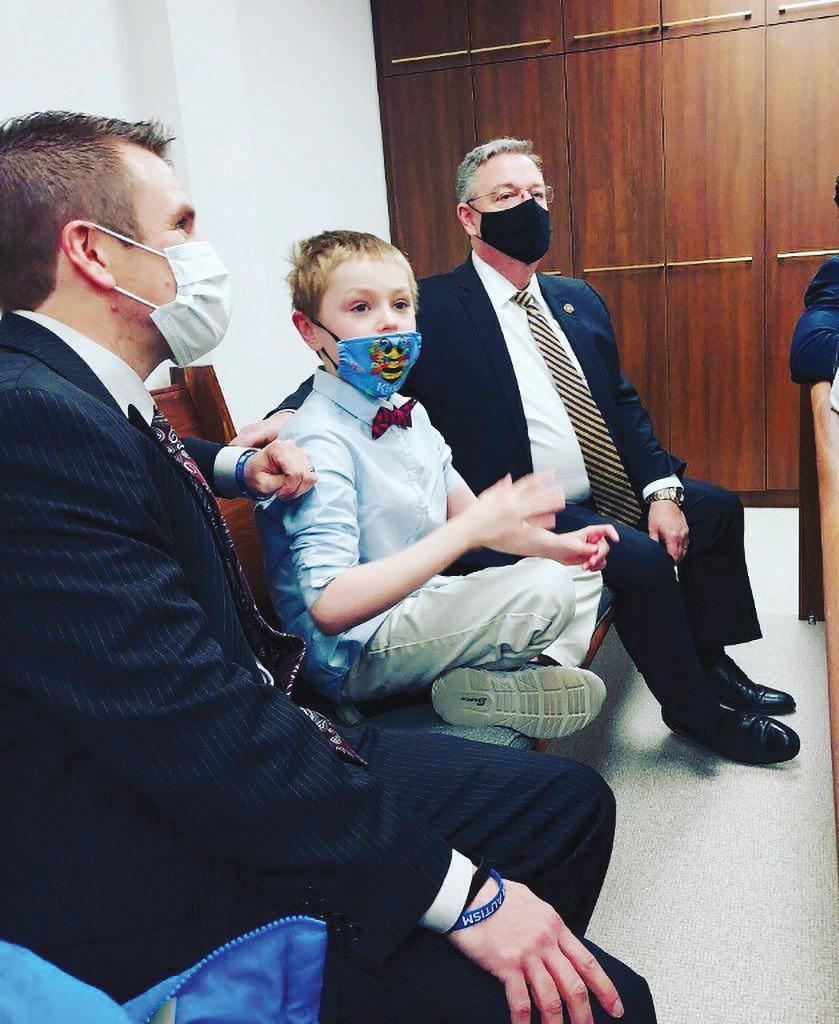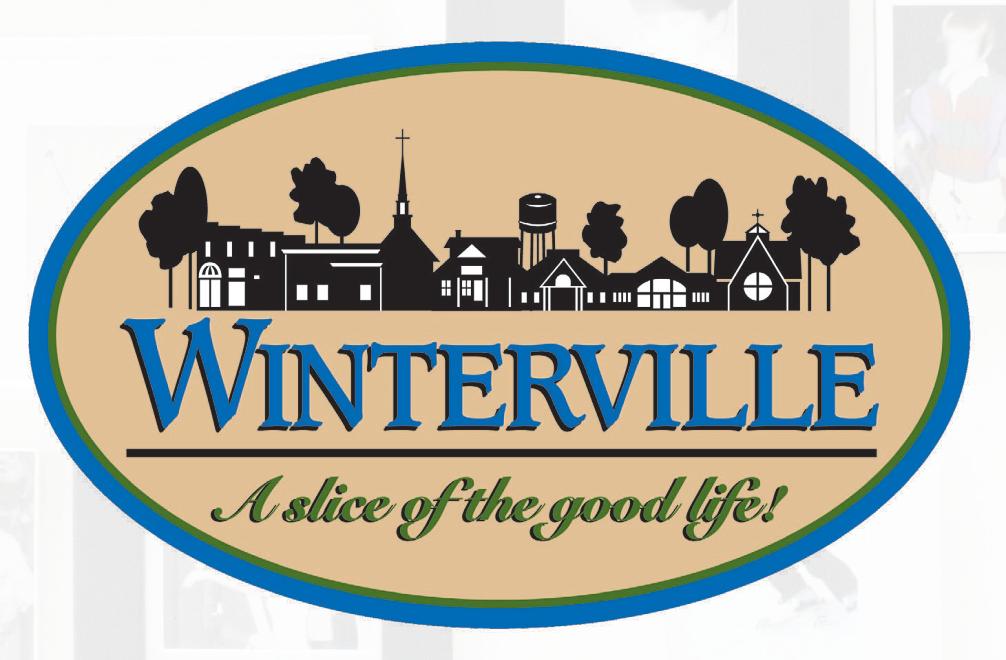




















Bobby Burns
Scott Davis
Beyonca Mewborn
Donna Davis
Kim Grizzard
Pat Gruner
Beyonca Mewborn
Donna Marie Williams
WINTERVILLE© is published annually by e Standard newspaper. Contents are the property of the newspaper and the Town of Winterville and may not be reproduced without consent of the publisher. To advertise in the publication, contact e Standard at (252) 329-9513.
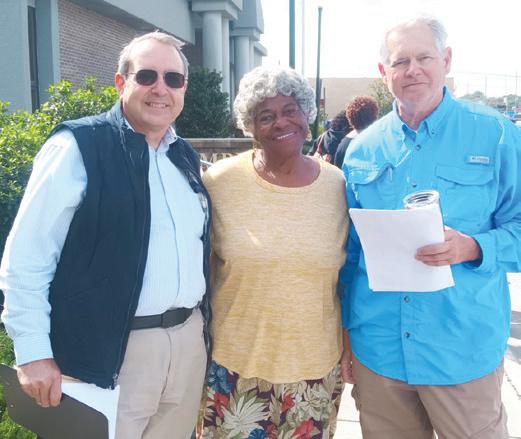
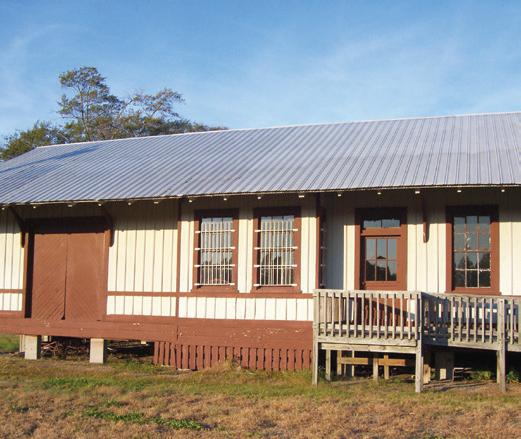
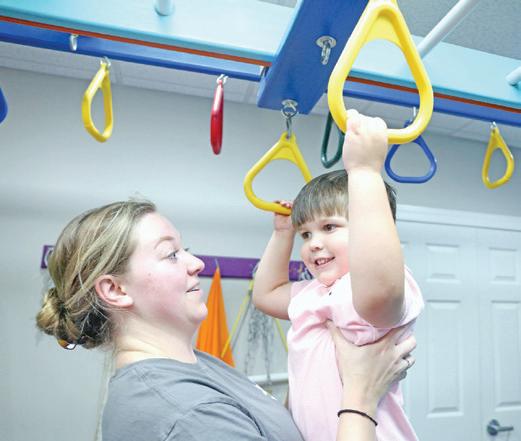



Quick bites are the staple at an upscale Winter ville cafe whose owners said a desire to constantly evolve is shaped by the town’s growth and an always changing industry.
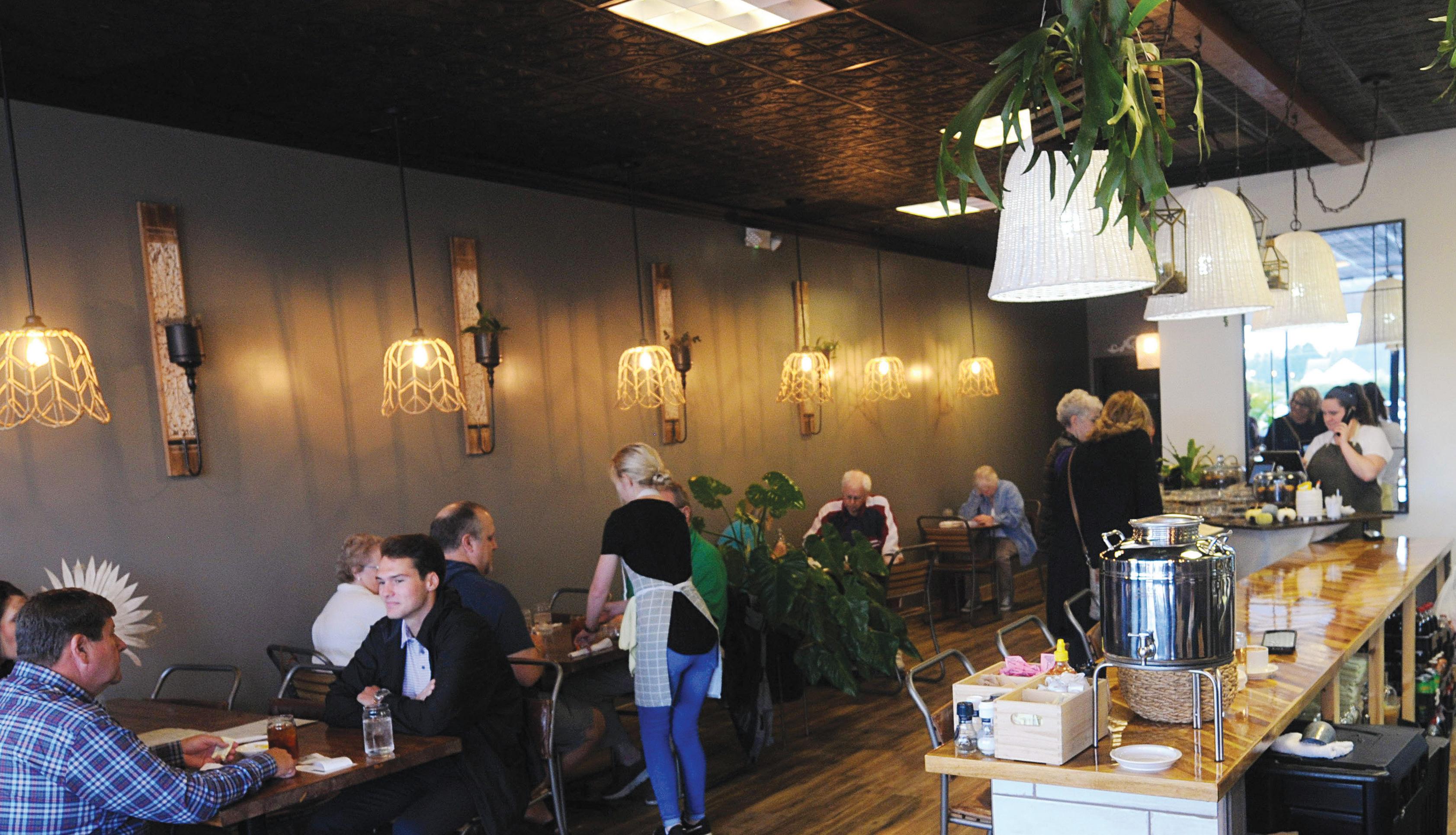
The Meating Ground Cafe, which opened in December 2021, is the product of timing and 60 years of kitchen experience among its owners, husband and wife, Shaina and Matt Cole, and Eric Pooley. The Coles are the owners of Prevail food truck, which began operation in 2020 as restaurants shuttered amid the COVID-19 pandemic.
As he hit the Pitt County
roads in the 1946 Chevy from which he slings Japanese fried chicken sandwiches and pork belly racos, Matt Cole found himself constantly coming to Winterville between catering gigs and stop ins at breweries. He noticed a pattern of growth and, with that, a perfect space for a restaurant in an aban doned Subway restaurant at the end of Winter Village shopping center on Old Tar Road.
“I saw this spot and I said ‘I have to have this spot.’ I’m right in the middle of something good here,” Matt Cole said.
So he and Shaina Cole purchased the location. She said that as she sat in
the space, the ideas began flooding in. On Sept. 28, 2021, she grabbed wallpa per in the corner and start ed pulling it down with her husband’s help. Pooley, who has served stints in kitch ens like CPW’s, Crossbone Tavern and Main and Mill Oyster Bar, would join the team later that year.
Within the cafe’s name is both a pun and its mission — to provide a communal space where people can get together, decompress and enjoy a good meal. The name and logo came about in the space of about two hours of brainstorming.
“I literally sat down one morning and thought, well, we have to name it,” Shari Cole said. “The name, Meating Ground, I think was a play on words. I wanted to hone in on ‘E-A-T’ where most peo
ple seem to focus on the ‘M-E-A-T.’ I wanted a place where people in Winter ville … can come together. Maybe it’s been a while. Maybe they’re having a business meeting, catching up with friends.”
What the cafe’s location is in the middle of, as the Coles and Pooler pointed out, are Ayden and Green ville The restaurant is situ ated about five miles from the center of both those municipalities. It is also in a deeply residential area of Winterville’s own burgeon ing population.
That growth has seen the town become a hot spot for young professionals, families and people relocat ing from across the country who would be drawn to the
cafe’s unique menu and service, according to Stephen Penn, the town’s economic devel opment planner. With that comes a need for upscale establish ments.
“Matt and Shaina Cole renovated the space into a beautiful and chic loca tion that displays the true visionaries that they are — in fashion, culinary arts, business, and placemak ing,” Penn said. “The con cept has been a huge hit for Winterville and residents throughout our area due to high demand for new restaurants in Winterville, their unique menu, the quality of their food and welcoming personality.
“Winter ville remains an amazing market for up-and-coming restaurants and other small businesses,” Penn continued. “One thing that most people don’t know about our town, is that Winterville has one of the highest median and average household incomes in North Carolina. In fact, Winterville has a higher average household income than Raleigh residents while housing costs are 75 percent less expensive.”
Matt Cole said the menu at the cafe incorporates el
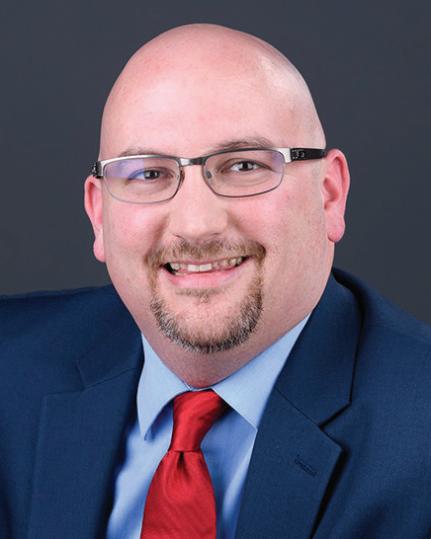
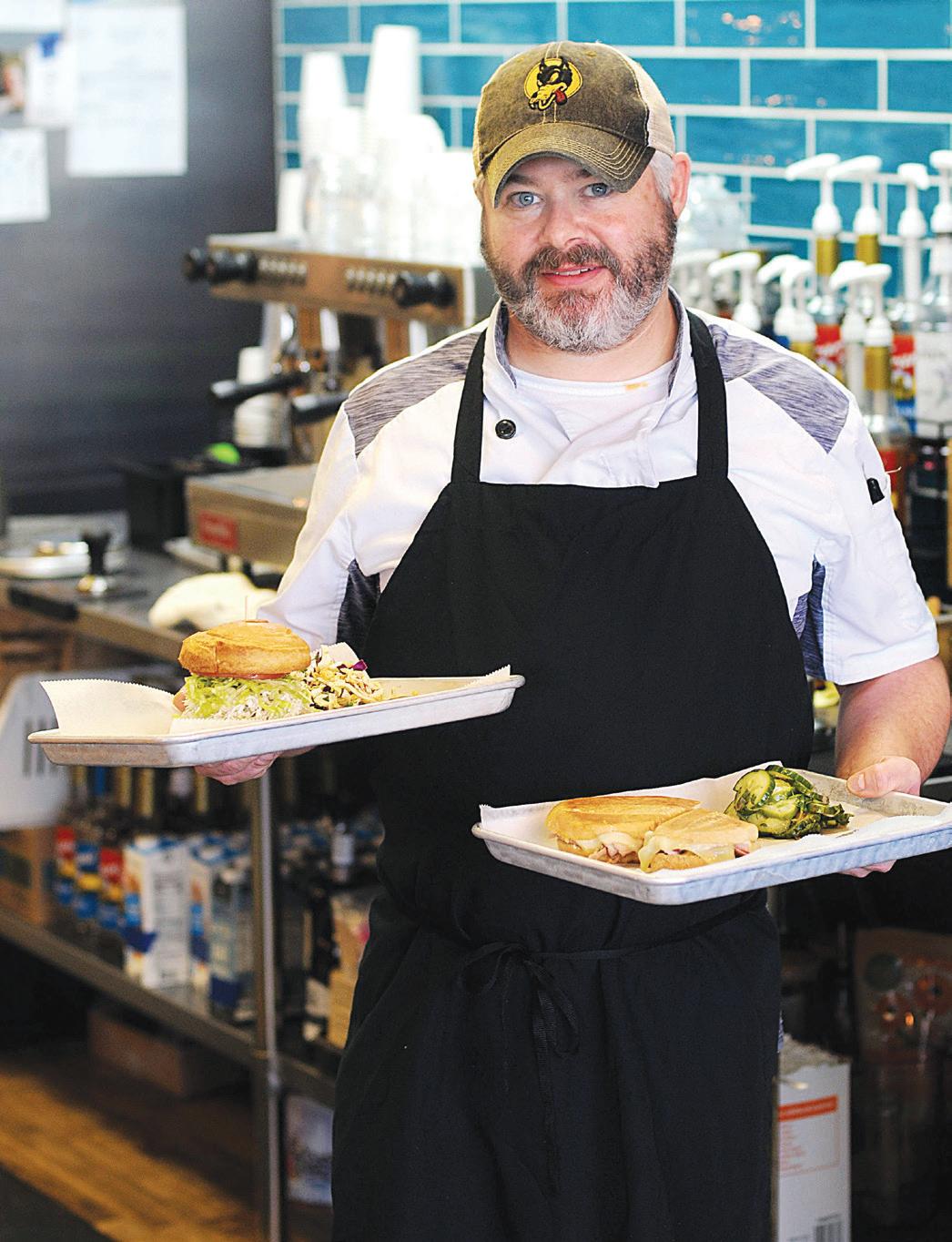
ements from Prevail, like Asian slaw, as well as from its chefs backgrounds. Pooler is from New Jersey, and a number of Italian styled cold cuts or presses on the menu let him cook in his hometown style. Matt and Shari Cole bring influenc es from their Charleston roots like pimento cheese and in-house chicken salad.
“Some of it is definitely inspired by Prevail,” Shari Cole said. “It’s kind of a blend of our background.”

“I just didn’t want any thing mainstream,” Matt Cole said. “I didn’t want to compete with Prevail. I wanted to bring different
con cepts, some different food, sandwiches that people had never seen.”
Social media has helped too. The Coles having an existing online footprint through Prevail served as a sort of signal booster, Shari Cole said, which took a lot of the load off when it came to generat ing followers and the buzz that comes with them for Meating Ground’s account. In less than a year the cafe has generated over 2,000 followers on Facebook.
“Without Prevail to pig gy back on it would have


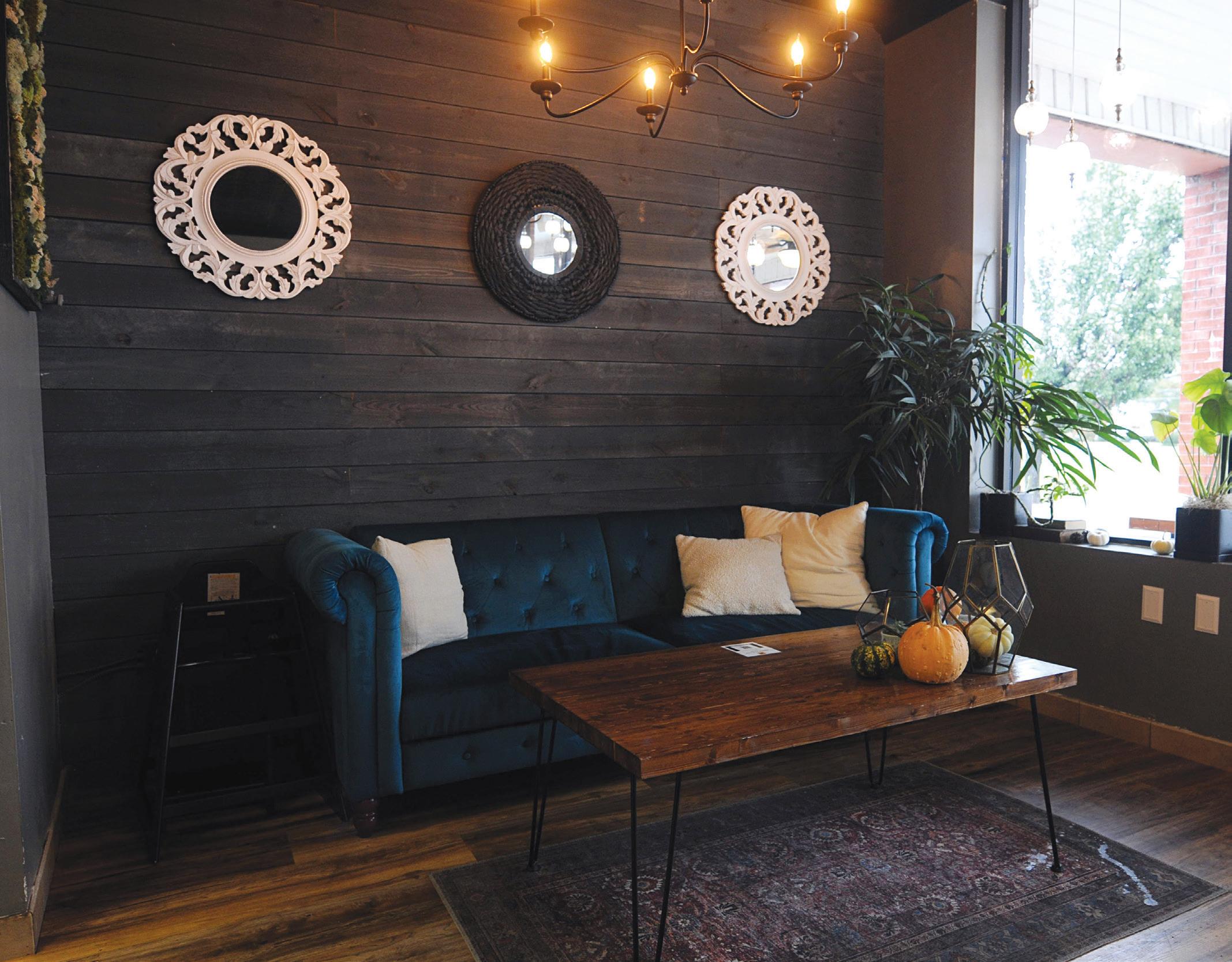

been a lot harder,” Matt Cole said.
Support for the cafe isn’t limited to the web, however. Many people, including town officials, are singing its praises online and off.
“Everyone has been really support ive of us around here,” Pooler said. “The mayor is here all the time. I think he’s my new best friend.”
Shari Cole credited Penn with be ing up to answer any question day or night in the restaurant’s earliest days. She said that David Moore, the town’s fire chief, is a regular too. His daugh ter now works at the restaurant.
Penn said seeing businesses like Meating Ground succeed is a testa ment to the work of its owners as well as carefully laid economic planning over the past quarter century.
“Though Winterville’s history goes back 125 years, much of our growth came within the past 25 years,” Penn said. “Winterville has more than doubled their population since the decennial census of 2000. Winter ville’s citizens, officials, developers, and staff have created an extremely unique city that exemplifies small town charm and family friendly design.”
But will Meating Ground be around 125 years from now? Shari Cole, always looking ahead, said that will require flexibility. So far, the cafe has adapted by changing its hours to its peak times, breakfast and lunch, and working in planned dinner events.
 –
–
“Businesses die when they aren’t exible,” she said. “With this, we saw dinner but wanted to focus more on breakfast and lunch. We constantly are evolving.”
Matt Cole said that generational di erences could have an impact on how the restaurant industry as a whole looks.
“We don’t just sell food here, we sell customer service,” he said. “What people don’t realize is that in 10-15 years customer service is going to be a commodity, because people don’t know how to interact. e way they grew up, the younger generation, is di erent. Not bad or good, di erent.”
One thing is for certain — the restaurant is quickly outgrowing its perfect space. Shari Cole said that cus tomers constantly ask when they will expand even though it has been open for less than a calendar year.
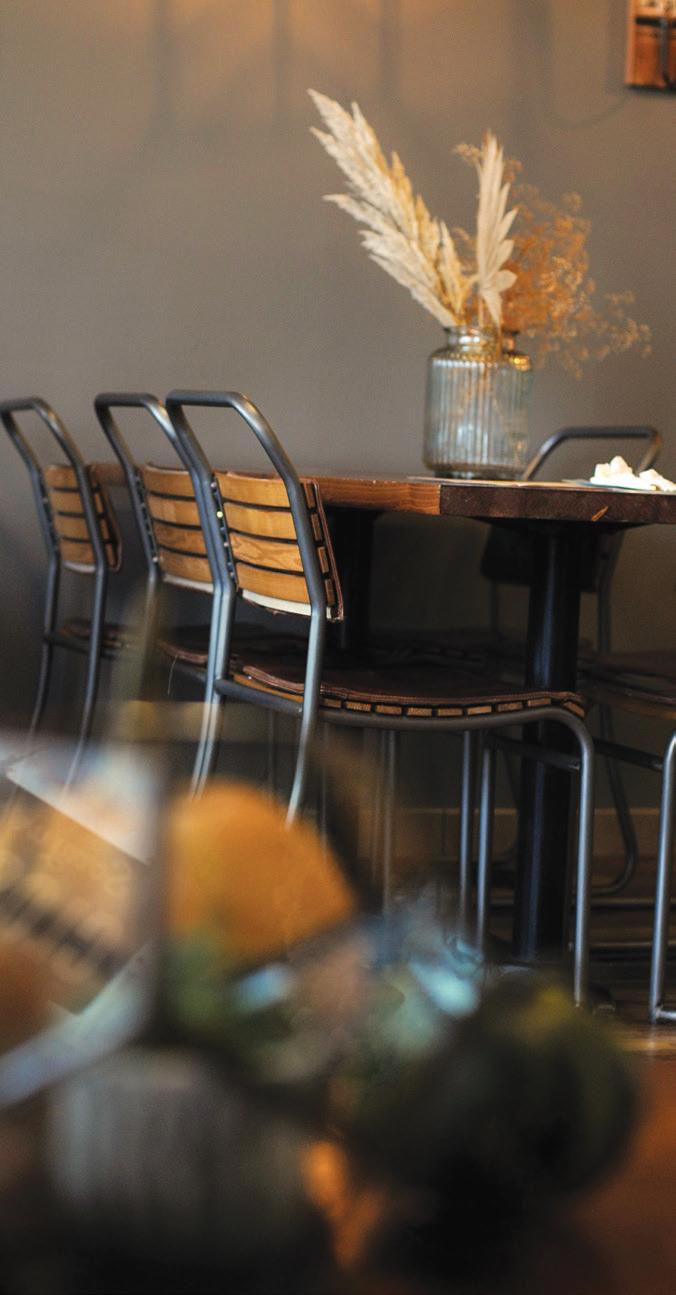
“I tell them, we just opened guys,” she said. “But this space, it is not un common to see every single seat full. On a Saturday, any Saturday anytime, you’re lucky if you get to sit.”
When or if the enterprise will expand remains to be seen. Right now, the owners are going with the ow in a town that they are grateful to work in.
“We’re just super grateful for how much Pitt County has supported us.”
“We don’t just sell food here, we sell customer service. What people don’t realize is that in 10-15 years custom er service is going to be a commod ity, because people don’t know how to interact. The way they grew up, the younger generation, is di erent. Not bad or good, di erent.”
Matt Cole
Year 2022 marks the 125th anniversary of Winterville, and in honor and cele bration of the quasquicenten nial, folks who love the town have been taking its history on tour.
Presented by the Winter ville Historical and Arts So ciety, the Oct. 8 tour began at 9:30 a.m. with a group of 10 tourists. Abbott Hunsucker navigated the route, and the town’s o cial historian, Jesse V. Riggs, was the guide.

“In commemoration of our 125th anniversary of incor poration we’ve developed a tour to take riders through Winterville, to take a look at the early sites of where the
town developed, and to talk about people who were sig ni cant in early Winterville,” said Riggs.
Riggs said that 500 years ago the Tuscarora hunted and farmed in the area and that Tuscarora arrowheads can be found in the elds around Winterville today.
“Near here is a trail that used to go from the Tar River to the Neuse River and it was referred to as the Indian Trail,” said Riggs. “In fact, in some of the early land grants, we see reference to that trail and part of Church Street’s extension connects to the route of that trail.”
In the early 1700s, as Euro pean settlers began pushing
in from the coast and down from Virginia, the area was considered part of the fron tier and was not settled many years. Eventually people moved into the area, began to clear land and use land that had already been cleared by the Tuscarora, and began farming by the early 1800s, said Riggs.
Riggs said deeds from the time include names like Cox, Ellis, Tripp, Ringgold, Brax ton, Stocks, Nelson, Manning, Cannon, Herrington, Jackson, Slaughter, Gowan and others. Following the Civil War, Afri can Americans began joining the list of landowners, and they were signi cant to the development of Winterville, said Riggs.
“In 1883 two African American farmers, Arden Dawson and Godfrey Mills, purchased some property in this area, and we’re not sure exactly the placement of that
property,” said Riggs. “But stories of early Winterville said that when the town began that (it) was on part of the land that had previously been owned by these two gentlemen.”
In 1887 they sold that land to Amos Graves Cox, whose family lived in the area and owned other farmland. Cox is considered to be the founder of Winterville. John Cannon Cox was not only father to A.G. Cox, but he was also a farmer, a wheelwright, a blacksmith and an inventor.
Riggs, who is descended from the Cox family, said John Cannon Cox developed a cotton planter which at the time was more accurate than other cotton planters and more economical to produce.
e cost-e cient, accurate cotton planter became very popular.
J.C. Cox patented a planter and eventually began to manufacture it. Amos Graves Cox took over the process of manufacturing, marketing and selling the cotton planter. It was the manufacturing and the selling of the cotton plant er that created Winterville, Riggs said.
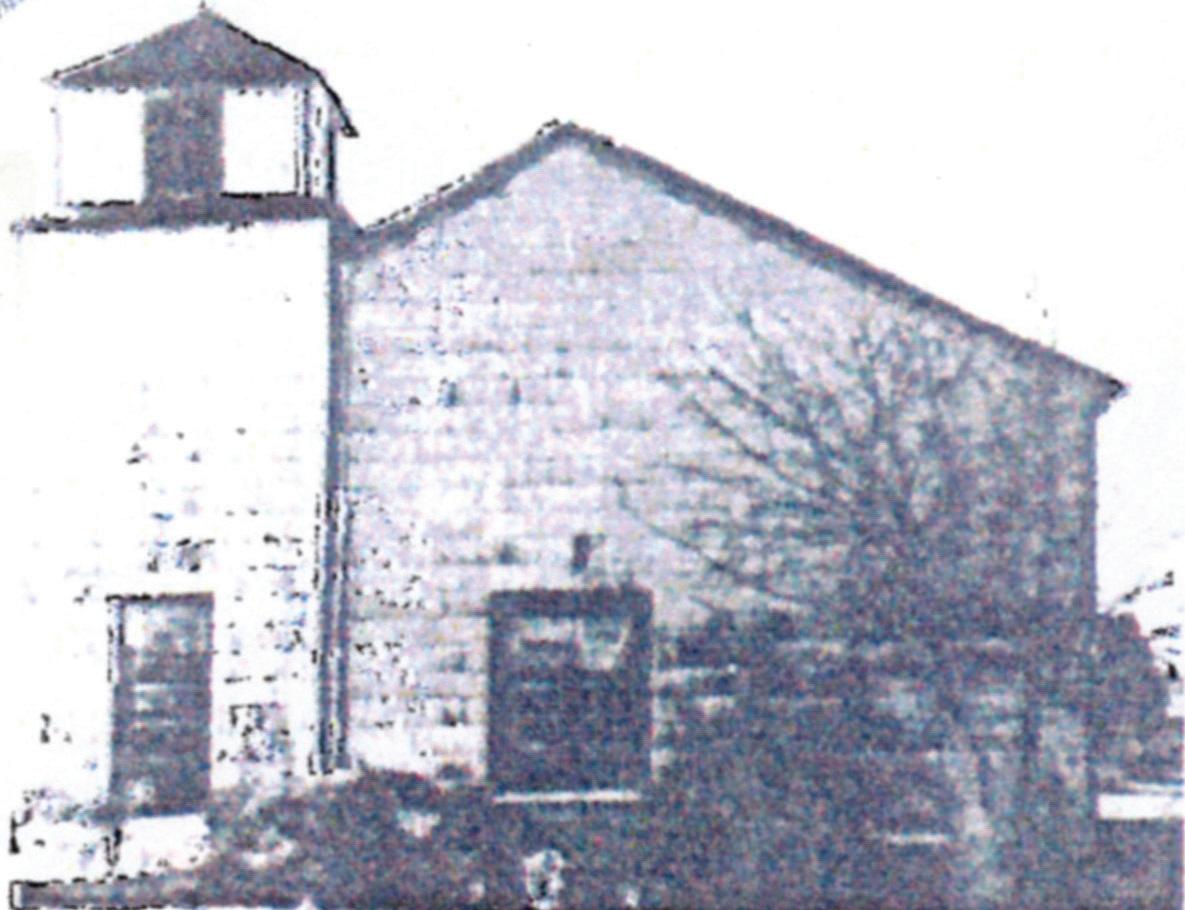
“
e industry around that eventually moved here and was the impetus for the town being here, for jobs being cre ated and for people moving to Winterville, and thus the

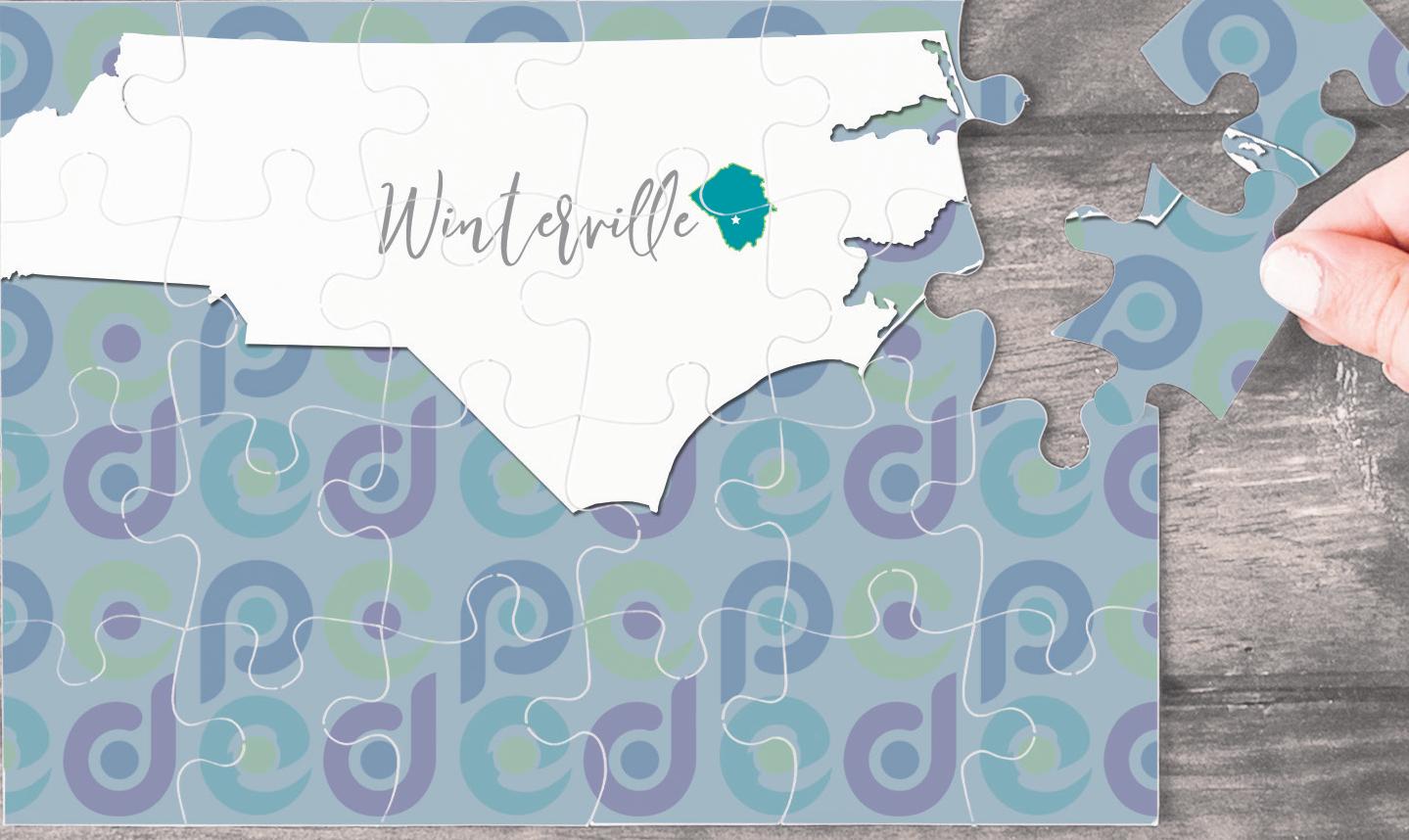
town growing,” he said.
Parked in front of the Win terville Town Hall at 2571 Railroad St., Riggs said that before 1890 there was noth ing there. “All you would have seen was woods and farmland with no town or roads.”
A branch of the Weldon and Wilmington Railroad came through in 1890, running from Scotland Neck to Kinston. It changed the dynamic of the area.
Cox had a manufactur ing company about a mile away. He contracted with the railroad to provide wood to fuel the locomotives, which had to stop to be refueled. Cox further arranged during the stops to load and unload
freight, including his cotton planters and other other items he manufactured to ship them to other points via the railroad. His business boomed and he moved it closer to the railroad.
More workers came to the
With ou rq ua lity of life,businessf riendlyenviron ment andstrong pa rtne rships, we have al lthe pieces in Wi nter vi lletoc reatebig oppo rtun itiesand bui ld la stingrelationsh ips.
area as the business increased, creating the need for support ing retail, services and com munity organizations. Cox sold and donated property for homes for workers, for estab lishment of new businesses and churches and a boarding school.
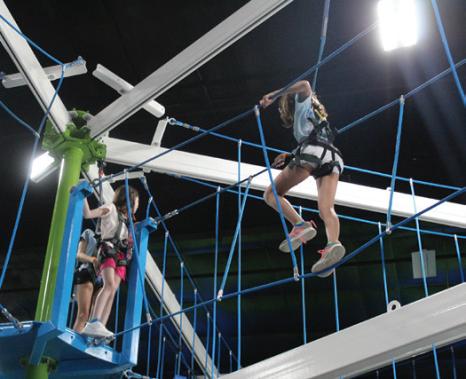


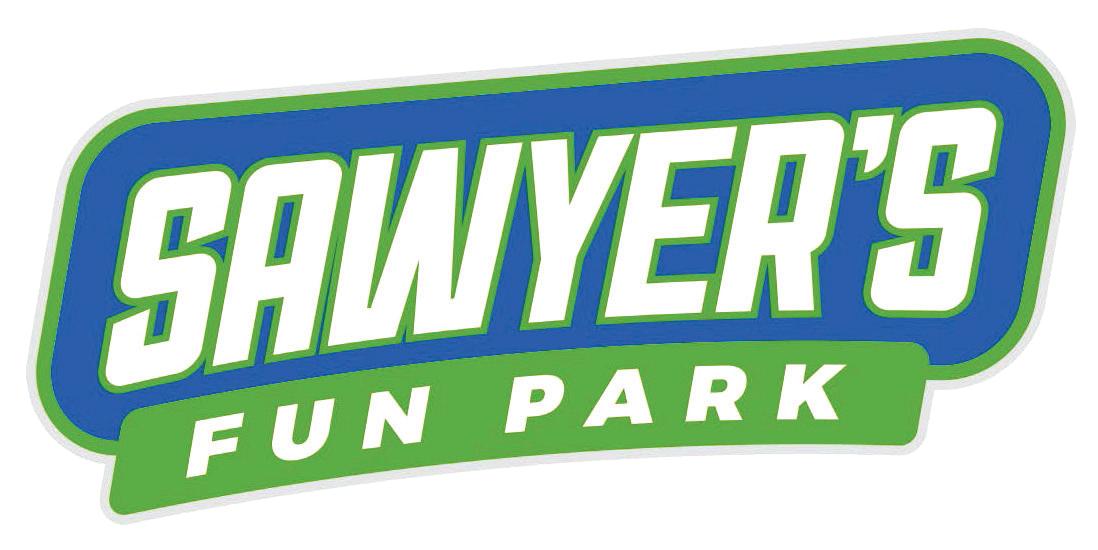
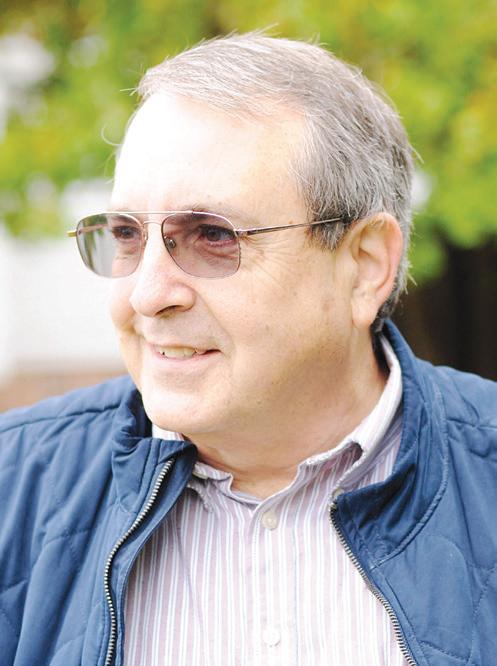
In 1891, a post o ce was established in A.G. Cox’s manufacturing plant. U.S. Post O ce Department agreed to name the post o ce “Winterville” a er a town in Georgia where Cox’s planter was sold, thus the budding community became known by that name.
In 1894, A.G. Cox had the
struc ture of his manufactur ing business physically moved adjacent to the railroad on the site of what is today the Main and Mill Oyster Bar. On March 3, 1897, the General Assembly rati ed “An act to incorporate the town of Win terville, Pitt County.” Today, the railroad runs north-south through the center of town, with East and West Railroad Street on either sides, lined with businesses, churches, municipal buildings, homes and a school.
e tour included a stop at Railroad and Worthington,
now home to the 1899 Winterville Depot, which grew from the stops the locomotives made to refu el with Cox’s wood. e depot (see related story on the depot) was another spur to the town’s growth, and stood nearby the Cox manufac turing plant at Railroad and Depot street.

Heading north on Railroad Street, the tour visited the town’s historically African American community. Riggs said in the town’s early days, visitors would have seen
leading citizens like Ola Gardener, who ran a grocery store and an auto mechanic shop; Rev. Henry Jackson and his son, Junie, who were skilled in moving houses and businesses; Norris Tucker, who ran a grocery store and a shoe repair business; and Joe Edwards, an electrician who also had shoe repair shop and
was the town’s rst line man.


e area was part of the early commercial district in the African American com munity. Central to the district was the Odd Fellows Lodge, a fraternal and a benevolent organization that worked to take care of the widows and orphans in the community.
ey also had a mutual burial association to help with buri als. e lodge reference in many of the older deeds from the time.

Next to the lodge was a store owned and run by Alfred Collins, who had a shoe repair business and also was a farmer. In 1918, Collins patented a machine to mechanically tie tobacco. Riggs said he shows up time and time again in documen tation about community initiatives and community events, especially in the Af rican American community. Collins bought the property from A.G. Cox in 1898, and it was a major gathering spot.
As the tour continued on Railroad Street, Riggs said the Masonic Lodge for the African Americans is still active and was built about 1912. Alfred Collins was one of the trustees of the lodge along with W.H. Gardner and Henry Frappa when they acquired this property from A.G. Cox.
e tour stopped at the original location of Mount Shiloh Baptist Church, which was very active in the com munity. Mount Shiloh was actually organized in 1879, before Winterville became a
town, then A.G. Cox gave them the property in 1904 for their church. Riggs said that appar ently he had already allowed them to erect a church build ing on the property before it was deeded to them.
Riggs said one of the things that he found interesting looking at that time in history was the number of people who were engaged in repair work, like shoe repair, auto repair, buggy repair, and farm equipment repair. He pointed out the area of Tyson Street near Credle’s Grocery, which is a landmark for folks who grew up in Winterville.
J.O. Smith had operated a variety store there. Also on Tyson Street in the early 1900s was the home of Rev. Alan Edwards. In Edwards’ home, a church was or ganized and they met for worship there until they were able to build a building in the 1920s at the end of Tyson Street, which is also the birth place of Good Hope Freewill Baptist Church.
Leaders in the community, with support of Cox and


others, founded what would become W.H. Rob inson School for African Americans in the town and surrounding area, helping to strengthen the community even more. (See related story on W.H. Robinson)


A signi cant industrial site on the tour was the location of the Winterville Cotton Oil

pany. e WCOC purchased cotton and sold cotton but also ginned the seeds from cotton. Riggs said some of those seeds were resold to be planted, but they also pressed cotton seeds to extract oil.
Cottonseed oil is still used today as a vegetable oil used in food processing and has many other uses. In the teens, some folks in Elizabeth City discovered that they could also press soybeans and extract oil from them. WCOC found that the same equipment and processes for cotton seed worked with soy bean oil, and for a few years Winterville was the second
leading producer of soybean oil in the United States.
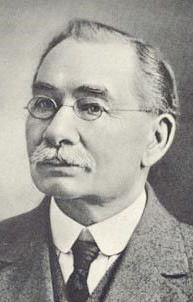
Today’s home of the Local Oak Brewery was the last home of what Riggs said was a beloved business called Worthington Cleaners. Worthington cleaners was es tablished in the early 1900s by Ernest Worthington, a mem ber of the African American community. Worthington op erated this business, then his family operated this business for a number of decades.
“Mr Worthington had a wonderful reputation and you could have written a book about customer service based on him, his life, his values, and how he operated

his business,” said Riggs. “Mr Worthington was known for his pickup and delivery service and … when we have people from Winterville gather and start talking about your business people … he is remembered for his kindness and his consideration for his customers.”
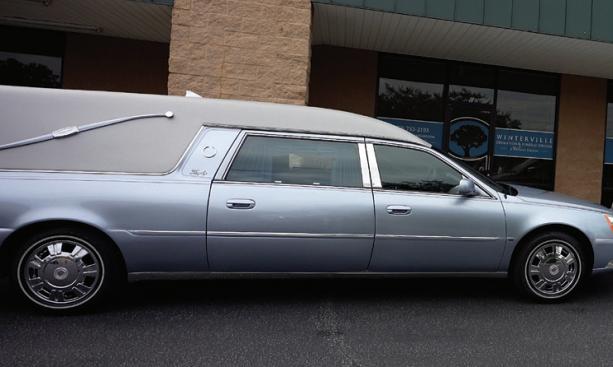
Today’s line of shops on West Railroad Street was built and completed in 1905 a er a re destroyed a row of wooden frame stores in 1904. In the middle of the block was the drug store owned and operated by Winterville’s rst physician, Dr. B.T. Cox. Riggs said that the re started over night in the drug store and
“
ere was another row of stores over on the east side of the railroad, and the newspa per accounts tell us that this re was so hot that it broke out the windows in the front
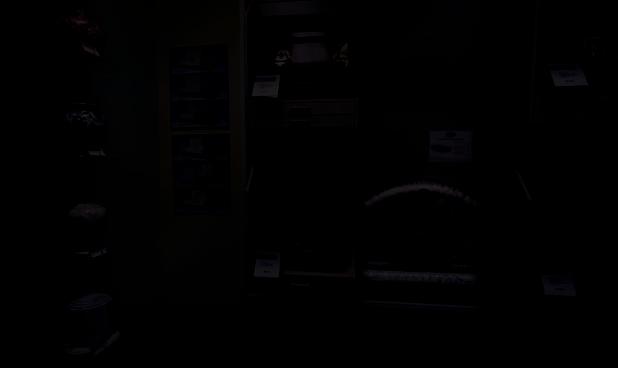
of the stores on the other side of the street,” said Riggs. “It completely de stroyed this row of shops, and were it not for the citizens of Winterville running in the cold to help put out the re, it probably would have burned the town down, but by 1905 these brick stores were built to replace it.”
On the corner beside the line of stores was where the location of rst Bank of Winterville. It opened for business in February 1906. “We we’re told that they did not actually have a safe for

mon
ey in the early days, but apparently that was not a a problem for them,” said Riggs.
Across the street, Riggs posted out the second loca tion for the Bank of Winter ville, built about 1920. “ e Bank of Winterville (backed by A.G. Cox) was one of the few banks in eastern North Carolina that did not close during the great depression,” said Riggs.
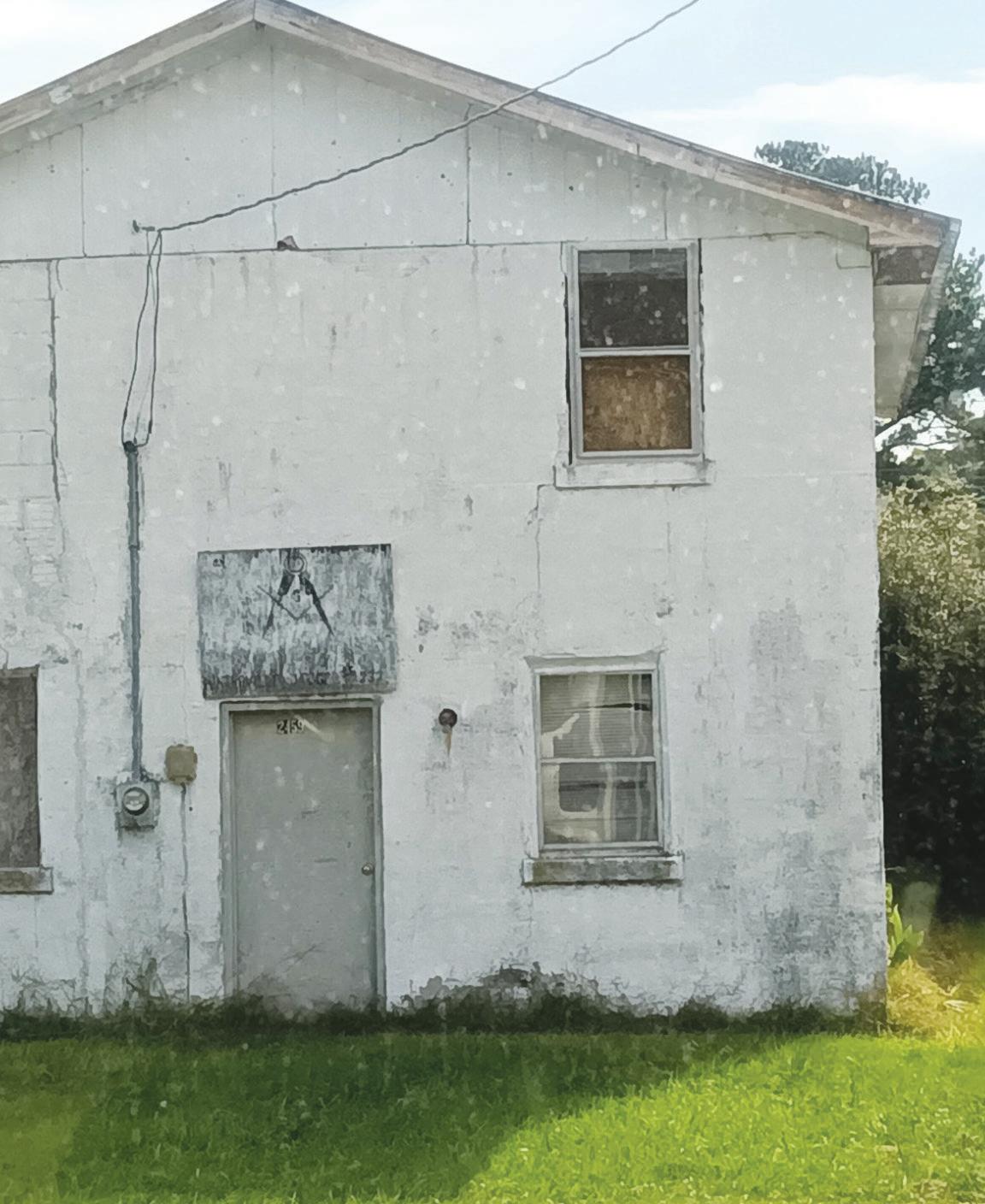
INDUSTRY, ELECTRICITY
e tour also stopped at the rst and second locations of the A.G. Cox Manufactur
ing Company. e tour brochure showed the rst location a er moving closer to the railroad in 1894. e second location was an impressive building and key to the growth of Winterville, Riggs said, because that was where the rst electric power was generated for the town.
Riggs said one of the town’s accolades is it was the rst municipality in Pitt Coun ty that had electric lights because A.G. Cox Manufac turing Company had an early generator called a dynamo, which generated electric power for their machinery and they sold electricity to the citizens.

“We actually don’t know the exact date Winterville was electri ed, but we do know that when the high school opened in 1900 that the buildings had electricity at that time. A er the manufac turing company outgrew that space, they located to where the Dixie Queen is now locat ed and with a bigger location occupied the whole block.”


e tour stopped at the site where B.T. Cox donated land for what was built as Saint Luke’s Episcopal Church. It was built in 1905 and oper ated as a Church until the 1950s. A er the congregation dwindled, Riggs said it even tually served as a classroom building for Winterville High School, which was across the street. e church later was the rst home of the Win
terville Museum. e home of B.T. Cox is still in the same spot on Church Street close by.
e Winterville High School also was important in the town’s development. A.G. Cox and others approached the Baptist Association to form a partnership to estab lish a private boarding high school. Both A.G. Cox and B.T. Cox donated land and resources for the school.
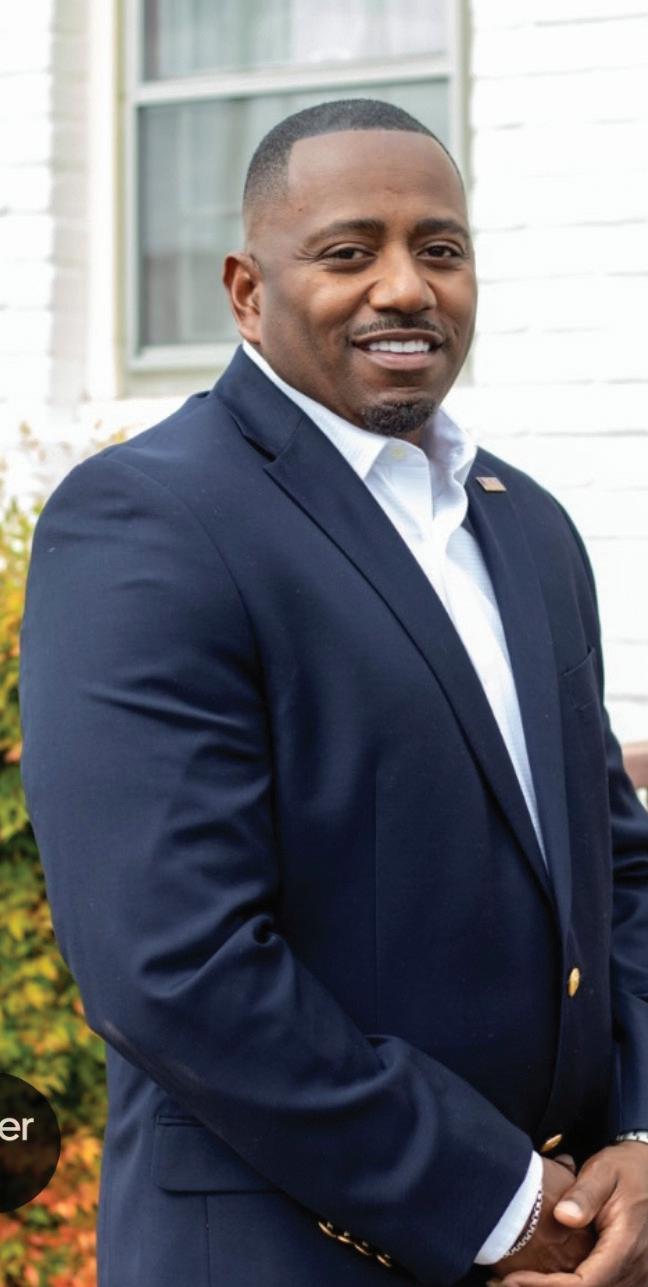
e school opened in the fall of 1900 and operated until 1919.
On Depot Street the tour stopped at the original location of Winterville FWB Church, which was built in 1905. at and was gi ed by A.G. Cox as well. e house that A.G. Cox lived was nearby.
e tour lasted for about an hour and 30 minutes, and a erward participants fellow shipped and swapped stories about their own recollection of the town.
“It’s important that we remember their names and be able to share their stories with future generations,” said Riggs. “It tells us about how people took what they had and made something bigger out of it.”
Mattie Nelson DeJesus moved to Winterville when she was 5 years old. e year was 1952, schools were segregated, and options for black students were limited.
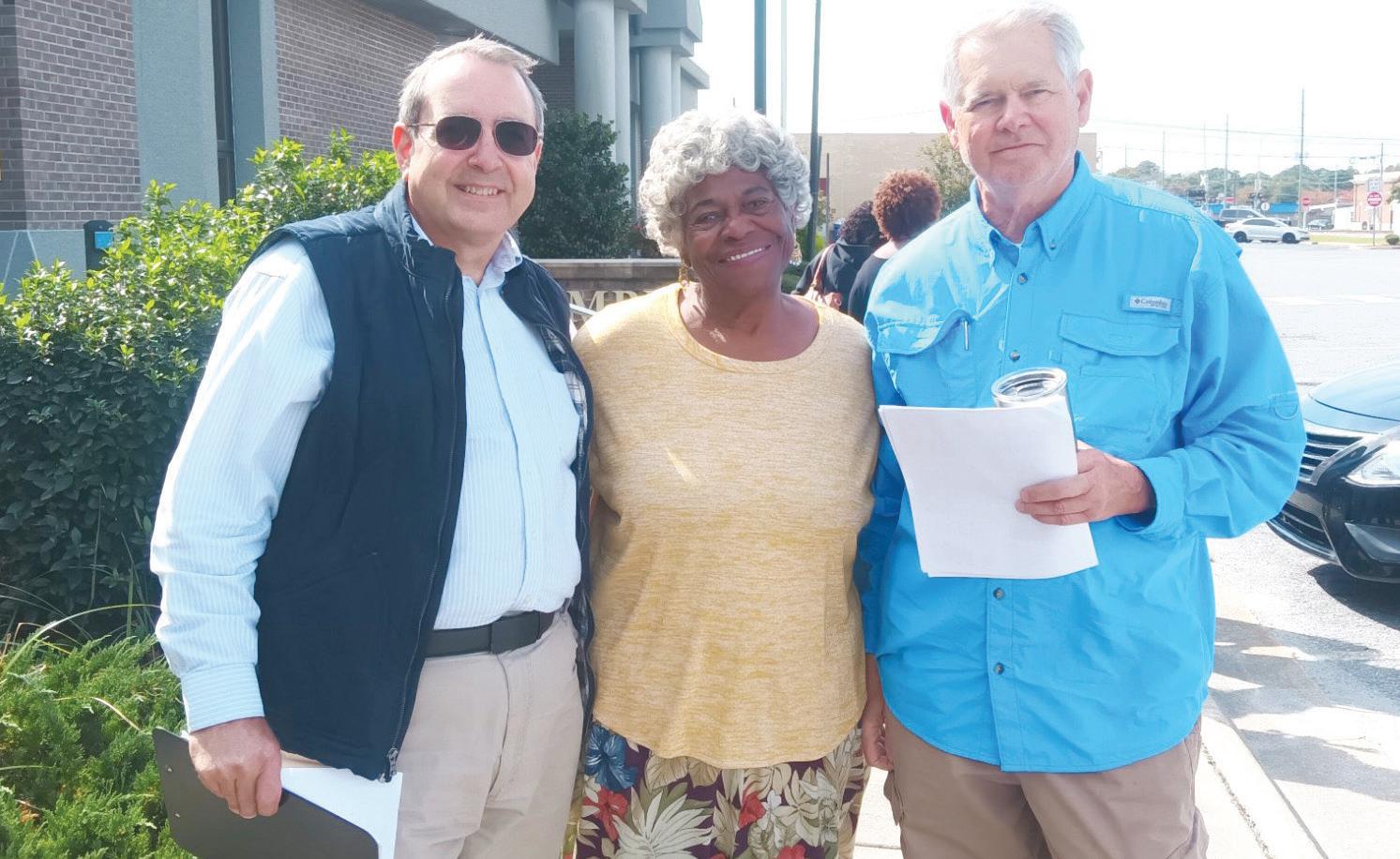
Fortunately for young Mat tie, Winterville had a strong tradition for educating its youth, regardless of color, and her days at W.H. Robinson School helped her blossom as an artist, she said.
“I loved my teachers, I did well, and I was an artist,” said
DeJesus, who was among passengers on a recent his torical bus tour of the town. “So in each grade the teacher would say before we start let’s see who here can draw, and everybody was saying Maddie so I ended up doing a lot of the bulletin boards and artwork for the teachers.”
She began school in 1954 at age 7 years because she was shy and wanted to wait for her sister, who was a year younger, to go to school with her.
She went on to graduate and study arts education at Elizabeth City State Universi
ty and like many of the grad uates went on to a successful life.
Education for African Americans in Winterville has its origins about the same time that public education for whites was in its infancy in North Carolina, accord ing to town historian Jesse Riggs. e rst public high school for whites, Winterville Academy, was built in 1900. Not long a er that, Alfred G. Collins and a number of the other leading citizens in the African American communi ty began working to address concerns that there be educa tional opportunities for their children.
Riggs said that one of the common themes that you saw for decades in Winterville was the value that citizens placed on education, regard
less of race.
e rst building to house what would become W.H. Robinson Union School was located on the corner of Rail road and Hammond streets, south of the Masonic Lodge, which still stands. e Pitt County Board of Education purchased the property but the building was paid for with funds raised by citizens in the community. It was described as very small and as a simple hut in many documents, according to Riggs.
Among the rst teachers was Mary Elks, who was mentioned in the Eastern Re ector in 1912, a couple years a er the school started. e short piece said it said it was a one-room schoolhouse and that Miss Elks is said to be a good teacher who was well spoken of. It went on to say
that she would be returning to teach in the next school term.


e school began to our ish, the number of students began to grow, but the build ing did not. By 1915 there was a need to have a larger building. e Pitt County board of Education ap proached Collins to purchase a piece of property on the corner of Boyd and Railroad street that same year. Collins and his wife sold their prop erty beside Mount Shiloh Missionary Baptist Church where a larger three-room school building was
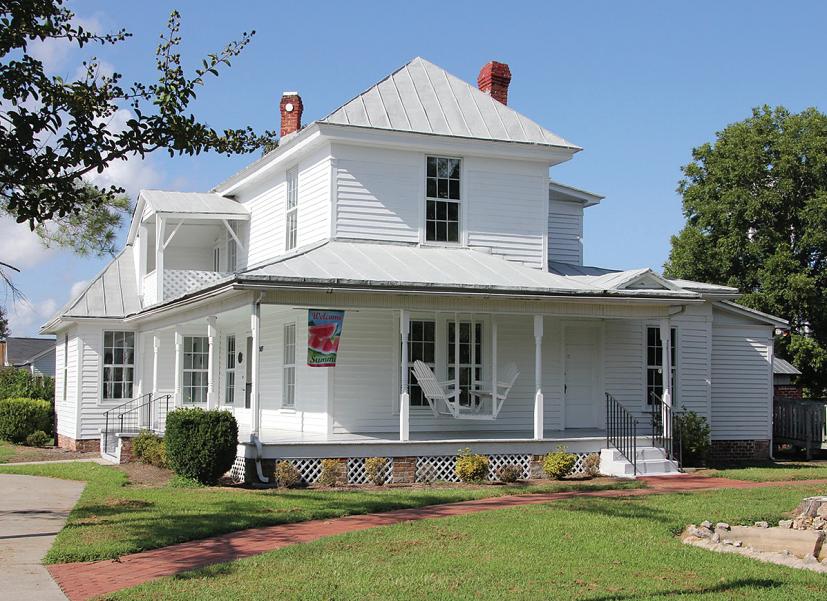
built.
Over the years Mount Shiloh was a good neigh bor and key supporter of the school that taught eight grades, said Riggs, including allowing it to use the church facility as an additional class room when more space was needed again. e building operated beside from 1915 through 1936 when a high school nally opened on property purchased to the Masonic Lodge on Railroad street, the building was built to eventually add the high school grade, and then over the years this building expanded and they were eventually able to consol
idate the schools, but for for a time the high school was on one side of the street and the elementary on the other.
In 1948, the school was named in honor of William Henry Robinson, who had been a teacher and a prin cipal. e facility continued to serve as a public high school for African American students until integration and consolidation of Pitt County high schools in the early 1970s. e building was repurposed as W.H. Robin son Elementary School and continues to serve students today.
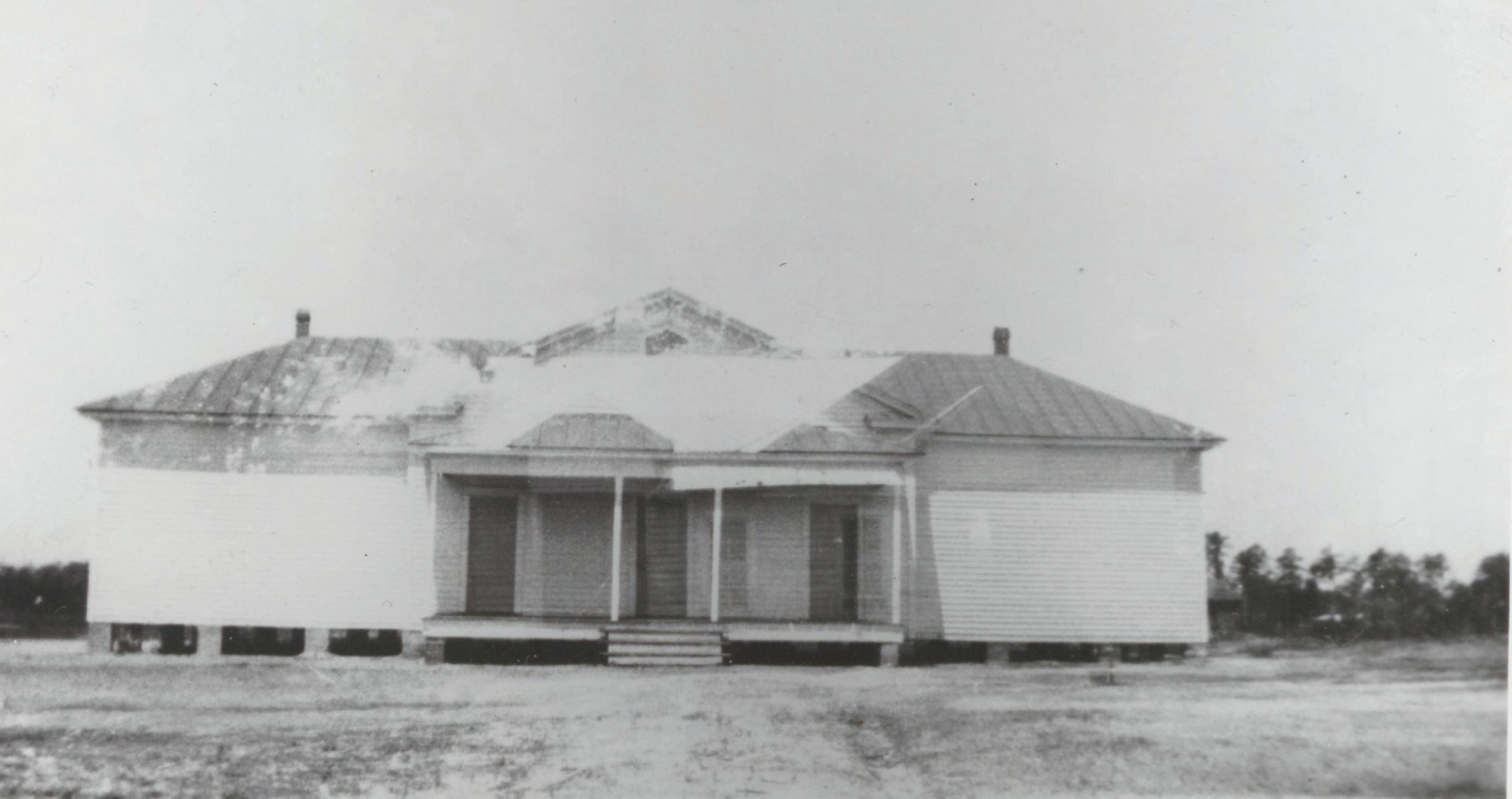
Over the years, the school was an integral part of Win terville’s black community, DeJesus and other graduates said.
John B. Hill, now 87, said when he and his classmates attended there were no school buses to ride, so all the stu dents had to walk in 1941. At that time they also used wood
burning stoves for heat and an outhouse for a toilet. But they still loved their school, he said.
“It seemed like it was more of a community thing because it seemed like the parents in the community knew who the teachers were, the teachers knew who the parents were and everyone was familiar,” said Hill.
He said that some of the teachers and admin istrators were from Win terville, some from other towns. Community mem bers would allow teachers to live with them, and the kids would sometimes run into some of those teachers walking to school just like the students.
Winterville Councilwom an Veronica Roberson, who attended from 1958-70, said attendance was mandatory for everyone growing up so school was a community ex perience. She said she walked
about three blocks to school every day no matter the weather. She said that every one in the community attend graduation n the gymnasium. “ ere was a lot of pride in the school and the things that the school did,” said Rober son. “We had very excellent teachers, they were expected to make home visits during the year and also attend one of the local churches a couple of times a year.”
Constance Ophelia Jones said was born and raised Constance Grimes in Win terville, and she began rst
grade in 1955 and graduated from high school in 1969. “We were called W.H. Robinson Union High, and it was a good school,” said Jones. “And they were good caring teachers.”
She said that back then the community, the school and the churches were intertwined, and the parents expected their children to behave without the presence of adults, especially at school. Jones said every body went to church together in the community, everybody knew everybody, all the kids played together, and every body raised you.
“There was a lot of pride in the school and the things that the school did. We had very excellent teachers, they were expected to make home visits during the year and also attend one of the local churches a couple of times a year.”– Winterville Councilwoman Veronica Roberson A three-room school building served Winterville’s black students for decades. (ECU Digital Collection)
“ at was the key part,” said Jones. “I don’t care who saw you do something that wasn’t right, they had your parents permission to chastise you, and when you got home your parents would chastise you as well.”
Such themes are common among Robinson alumni. e community had a vested inter est in the success of the school.
“ e community raised all of us and you weren’t disrespectful to anybody in the community,” said Jones.
“When you went to school or even church without your mama, you knew how you were supposed to act, and you acted accordingly because somebody there would give you the look.”
“
e teachers had to come to our homes to conference with our parents,” said Rober son. “And even if they weren’t a member, the teachers had to visit the churches, too.”
“It was more of a commu nity raising each other and you knew the parents knew
that teachers would keep them knuckles or keep them thighs with a ruler to them,” said Jones. “And they had no problem with it because they knew that their children were not being abused.”
DeJesus said she remembers getting the paddle to the back of her hand for being late and not passing inspection. Hill re called on teacher in particular.
“Mrs. Jones was a lovely sweet lady, but I tell you what, she would put a paddle to you,” said Hill. “She would swipe
your coat tail or your pant leg if you didn’t do right’ and then would tell your mom.”
Many of today’s alumni at tended Robinson in the height of the civil rights movement. ey were the last all-black classes to graduate from the school.
“I remember the teachers brought loose small TV’s to school and we would watch the marches,” said Roberson. “We watched the funeral of John F. Kennedy and Martin Luther King Jr.”

The year was 1897 and the people of the newly formed town of Winterville wanted a depot to access the trains that had helped spur development in the area.
Problem was, according to historian Jesse Riggs, Green ville and Ayden already had depots and the Wilmington & Weldon Railroad Company didn’t want another stop so close between. Long story short, the town sued and won.
Years later, as commerce and rail tra c changed, the stations in Greenville and Ayden were torn down, and Winteville’s was headed for
the same fate.
rough the e orts of preservationists, a trip to the county fairgrounds and a trip back to town decades later, the Wintervile Depot that almost wasn’t is now the only one of the three that remains and continues to serve the townspeople who have helped shepherd it through the years.
e story of the depot began before the town of Winterville was incorporated and was the work of dedicat ed individuals who sought to enhance the soon-to-be town. One of those people was Amos Graves Cox, who later donated the land in which
Winterville was established.

Cox was also the owner of the A.G. Cox Manufactur ing Company, a prosperous industry at the time, accord ing to Riggs, Winterville historian and member of the Winterville Historical and Arts Society (WHAS). Riggs served as president of the society during the time of the depot’s move back to town.
In 1890, Cox contracted with the Wilmington & Weldon Railroad, the owner of the railroad track that runs through Winterville, to supply fuel for the wood burning locomotives. Because of this contract, the railroad established the “woodrack.”
e woodrack was located in what would become down town Winterville and allowed the trains to stop and refuel.
While there are no pictures of the woodrack, Riggs be lieved it consisted of a simple wood storage rack. e rack held the wood used for fuel
until it was unloaded, Riggs said.
Passengers traveling were also welcome to board the trains, but had to do so by agging the train down. e same was true for those need ing to ship goods.
With no structure, this meant passengers and cargo had to be li ed to the train cars, Riggs explained.
Passengers and cargo con tinued to be picked up in this manner when the locomo tives switched from wood to coal.
While the woodrack was useful, it was not a fulledged depot and did not meet the needs of the grow ing town.
Cox continued to pur sue Wilmington & Weldon Railroad to establish a station; the railroad did not want another stop because depots already existed in Ayden and Greenville already.
e town, which incorpo
rated in March 1897, sued the railroad that same year. e railroad settled with the town but only if the town furnished the building materials.
In April 1899, the depot was completed and existed at the intersection of Railroad and Depot Streets. Before the end of its life as an active train station, the warehouse section of the building had been expanded several times and was approximately 160 feet long.
Its existence further helped Winterville grow and the town took advantage of the railroad line.
“By putting a depot here, it better accommodated ship ping freight. Before, if you had something you needed to ship, you had to wait at the railroad with your item and
ag it down. With the depot you had a facility that was able to hold freight and goods that were able to ship out. It could be purposely loaded on the train,” Riggs said.
“With a platform designed
to be the same height as the boxcars, it made it much easier to load things.”
e depot continued to provide passenger service until the 1940s and freight services until the 1960s.
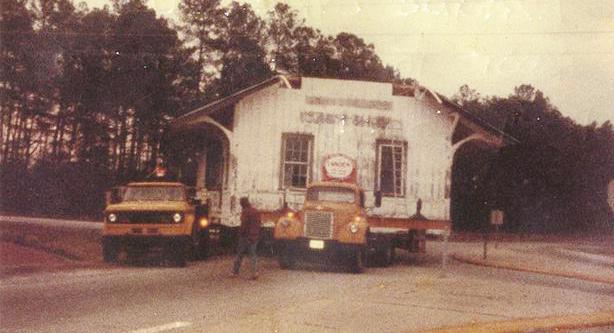
A er freight service was discontinued, the railroad leased the building to Swi Fertilizer Company until about 1982.
e railroad later declared the depot surplus and de

cided to demolish it because it did not want to pay for upkeep.
When the railroad in formed the town and community of its intentions, the newly formed Winterville Historical and Arts Society, was tremendously concerned about losing this historic structure.
e society was unable to raise needed funds or secure a place to relocate the structure, however, so mem bers reached out to Lester Turnage and Connor Eagles, founders of what is now the Eastern Carolina Village and Farm Museum to see if they could be interested in helping to save the depot, Riggs said.
Turnage and Eagles understood the importance of the depot and its role in Winterville. ey believed it was worth saving, said Joanne Honeycutt, a member
of the board and daughter of Eagles.
“ ey felt like it was a tremendous piece of history. at is always the focus of the historical group. e value of the historical artifact — the original building,” Honeycutt said.
“It certainly represents an unbelievable era of growth in Pitt County. It represents when the trains started com ing through the area. Trains meant growth, and of course Winterville grew from having those train tracks through the area.”
Members of Eastern Carolina Village and Farm Museum board, then the Village of Yesteryear, sprung into action and worked to raise the money needed to move the depot to the Pitt County Fairgrounds, where the Village had established a museum of historic and original buildings.
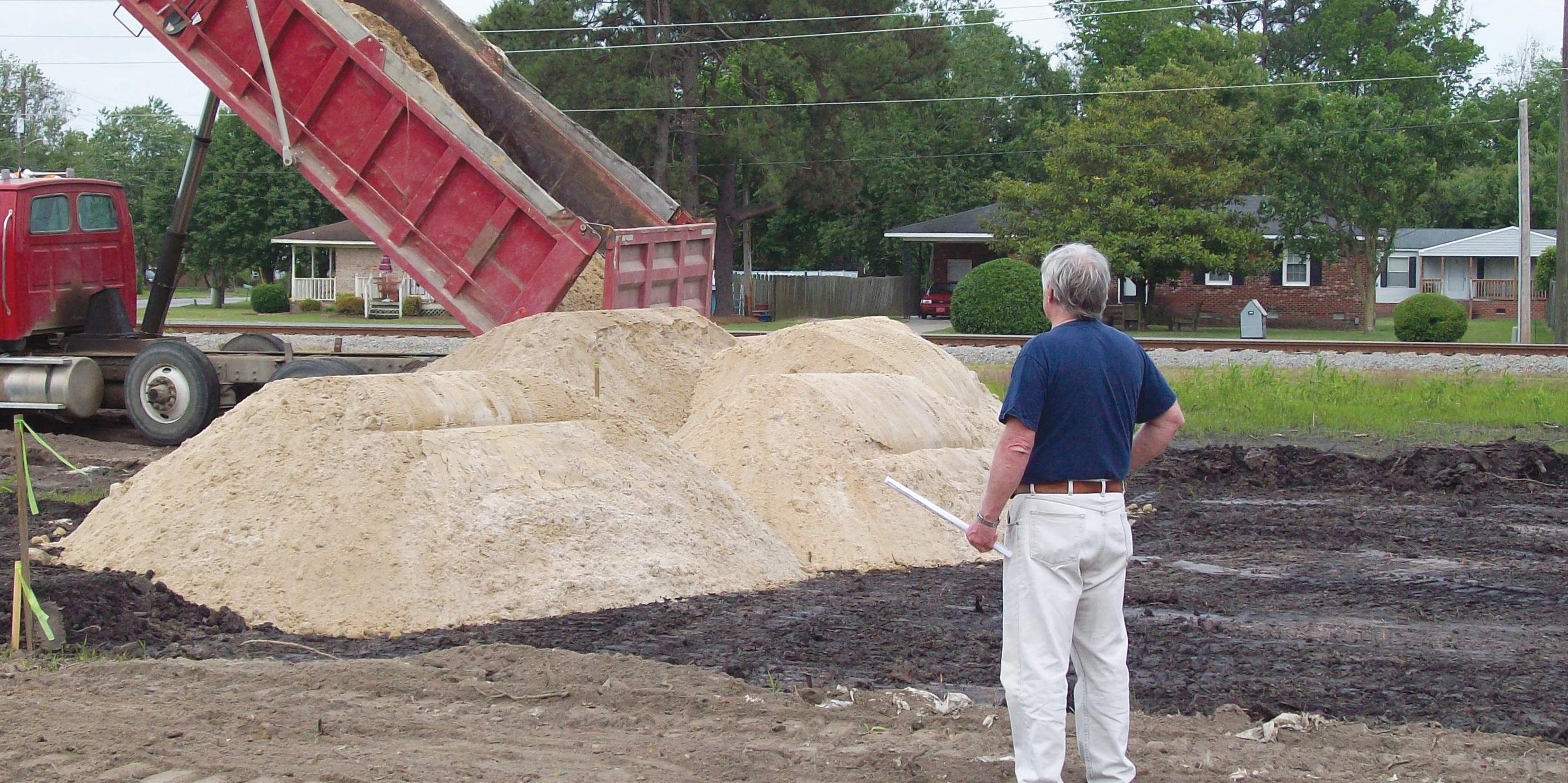
“ e board thought it would be a good place. ere
was a perfect spot for it at the fairgrounds,” Honeycutt said. Winterville preservation ists believed if the depot could not be saved and kept in Winterville, the next best thing would be to relocate it to the Village at the fair grounds, according to Riggs.
In 1978, the Village established an agreement with the American Legion, who owned the Pitt County Fairgrounds, for the estab lishment of a museum which consisted of several historical and original buildings. e Depot was one of the last buildings to be set on the property, Honeycutt said.
“It was unbelievable. ere were close to 20 buildings out there. Quite a few log buildings from old tobacco barns,” Honeycutt said. e decision to move the depot to the fairgrounds did come at some costs to the depot; however.
“When the decision was made to let the village move
the depot, it was decided to reduce the size of the build ing by tearing down most of the added warehouse space, but saving the passenger area, station master’s o ce and some of the oldest por tion of the warehouse,” Riggs said.
In 2006, the Historical and Arts Society learned that the American Legion Fair Board was planning other uses for the property the buildings were sitting on, and that the Fair Board had decided that the buildings of the Village would have to be removed. e society began mobiliz ing to bring the depot back home.
Fundraising e orts were initiated, and the search for a suitable new location begun. In March 2008, a er negotiations with repre sentatives of the Board of Directors of the Pitt County American Legion Fair, Riggs, made a formal written re quest to Ed Adams,
of the fair board, asking the fair board to give WHAS the depot and caboose to be moved to back to Winter ville.
In the request, it indi cated to the fair board that WHAS had raised more than $65,000 toward the cost of moving and setting the building on a new founda tion. In the same month, the Board of Directors of the Pitt County American Legion Fair approved a transfer of the depot and caboose to the society.
WHAS was able to return the depot to Winterville in July 2009.
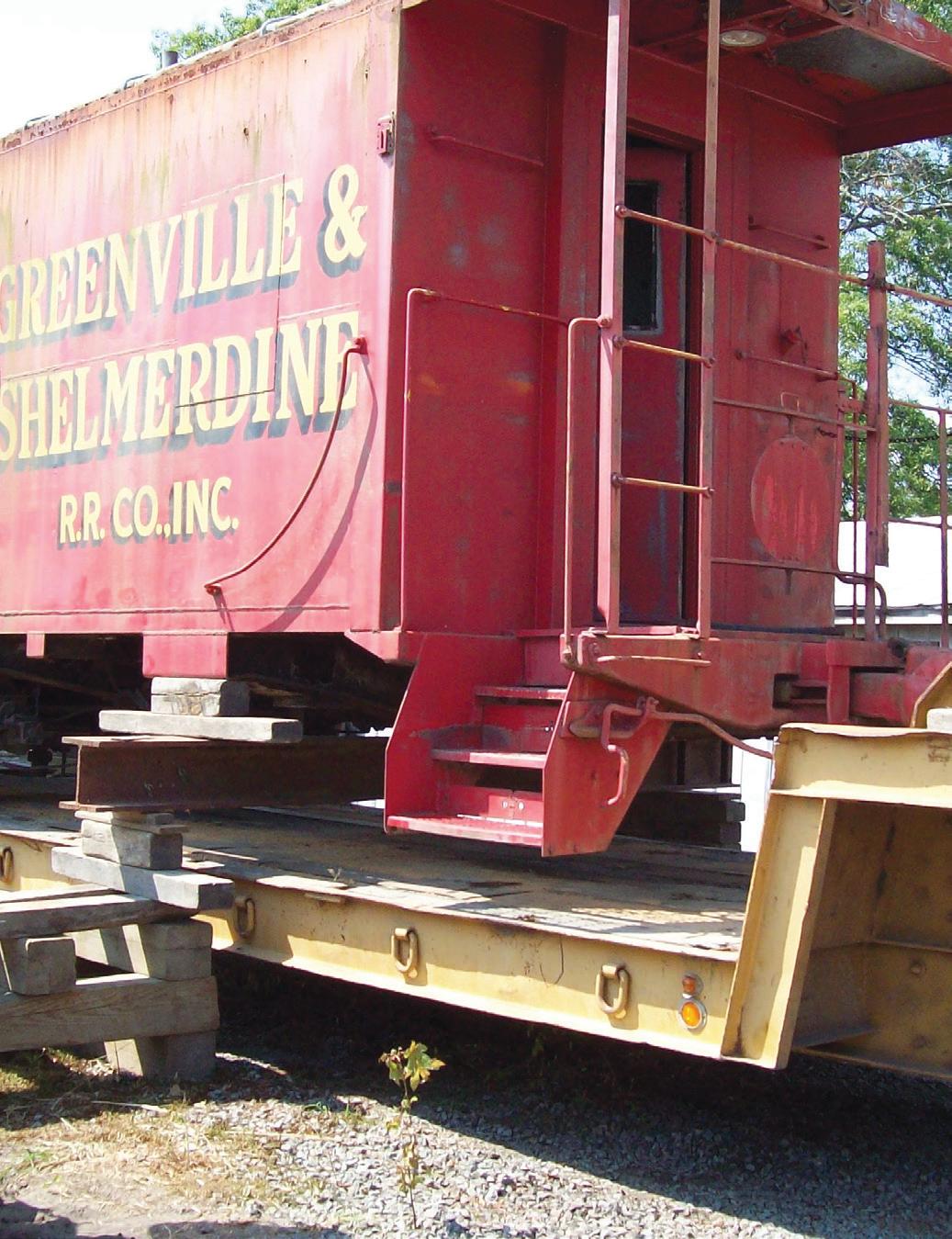
e return home to Winterville was arduous and lled with bumps along its journey. But it was a journey that Derek Allen is glad to have been a part of.
Allen now resides in Hen dersonville but once served on both the town of Winter ville’s Planning Board and on the historical society board. It was during his time on these boards that he accom plished his proudest achieve ment — helping to bring the Winterville Depot home.
“ ere were some hard times and a lot of good times. e important thing to me is I managed to get the job done. at job could not have been done without the help of Riggs,” Allen said. “I am extremely proud to say, ‘Yes, I was the project manager.”
To do this was a task that required a lot of hard work, dedication, and funding.
“Jesse and I put our heads together and wrote some
grants. I put together the gures and plans and Jesse put everything into words. We presented several grants,” Allen said.
Together they were able to raise $350,000 through grants. Funding including money to move the building, refurbish it and reopen it for community use.
e Depot was also in need of a permanent location to call home and land was required.
“I negotiated with Mary Virginia Langston about land to put it on. She was kind enough to donate the property where the Depot sits now,” Allen said. e property was deeded to the society in January 2009.
e depot now sits at Langston Park, located at 217 Worthington St. It is named Langston Park in honor of Langston’s parents Don and Mary Ida Langston.
With funding and a loca tion, organizers now had to focus on the intricacies of the move itself, which was easier said than done.
“Electric lines had to be moved. We had to get the materials set up and get the lot ready for the depot, which was a big job,” Allen said, adding he took the job very seriously and did much of the design work himself.
“I designed the foundation and piers for it to sit on.”
Finally, a er much work and anticipation, the depot and caboose were home, but it needed repairs before it could be used by the com munity.
With persistence on his part, Allen was able to secure donations from many in the community to perform the
needed repairs.
“It was in awful condition. It took an awful lot to bring it back to where it is now,” Allen said.
“I got 70 percent of ev erything donated. What we spent, we spent mostly on labor. Everyone who had a hand in this deserves credit. I learned a long time ago that if you are honest with people and honest about what you are doing and let them know you need the help, they will help.”
rough the restoration process, Allen and others worked hard to restore the depot to as close to the orig inal condition as possible. He worked with the N.C. Department of Natural and Cultural Resources State
Historic Preservation O
on the design and was able to review old photographs of the depot.
“I conducted extensive research on the construction of the Winterville depot and other depots of this type. Using old photographs of identical depots, I deter mined that these depots originally had wraparound platforms and steps. Later, we found the structural evidence on the Winterville depot for the platforms and eventually discovered an original photograph of the Winterville depot with the wraparound platforms and steps intact,” Riggs said.
Allen was also able to recover chips of the original paint hidden under multiple
layers of newer paint.
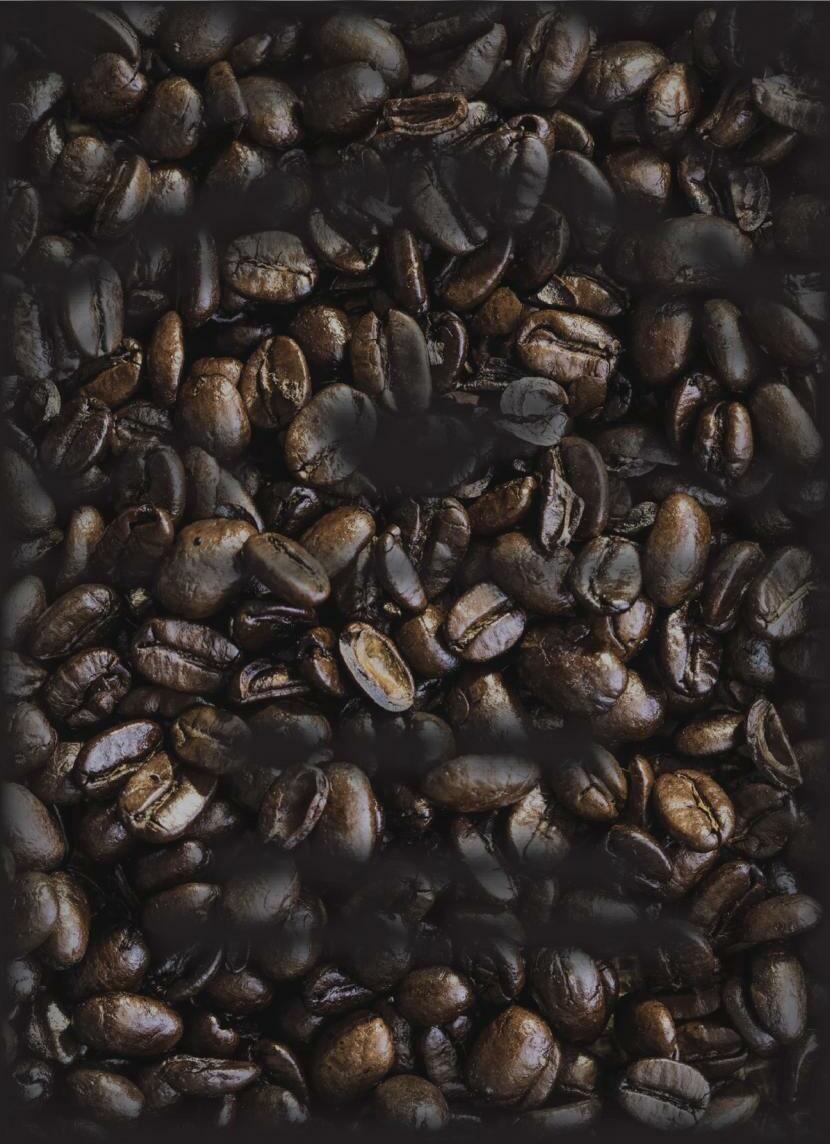
“We wanted it as close as possible. We did not change anything on the exterior. I found an original picture of the depot that showed what the original deck looked like and what the steps were made of,” Allen said, adding employees at Sherwin Williams helped to match the original paint color.
Riggs and Allen also were able to replicate signage that declared the station was Winterville’s.
“One of the proudest moments for me was when we were able to return the Winterville name placard to the end of the building. e original was lost when the depot was moved to the fair ground. A replica duplicating the size, location, and color was created based on old photographs,” Riggs said.

Today the depot sits proudly serving not only as a reminder of history but as a place for the community to gather.
“ e structure of the depot goes back to the very early days of Winterville. It was one of the important community gathering places. People traveled to and from Winterville largely by way of the train,” Riggs said.
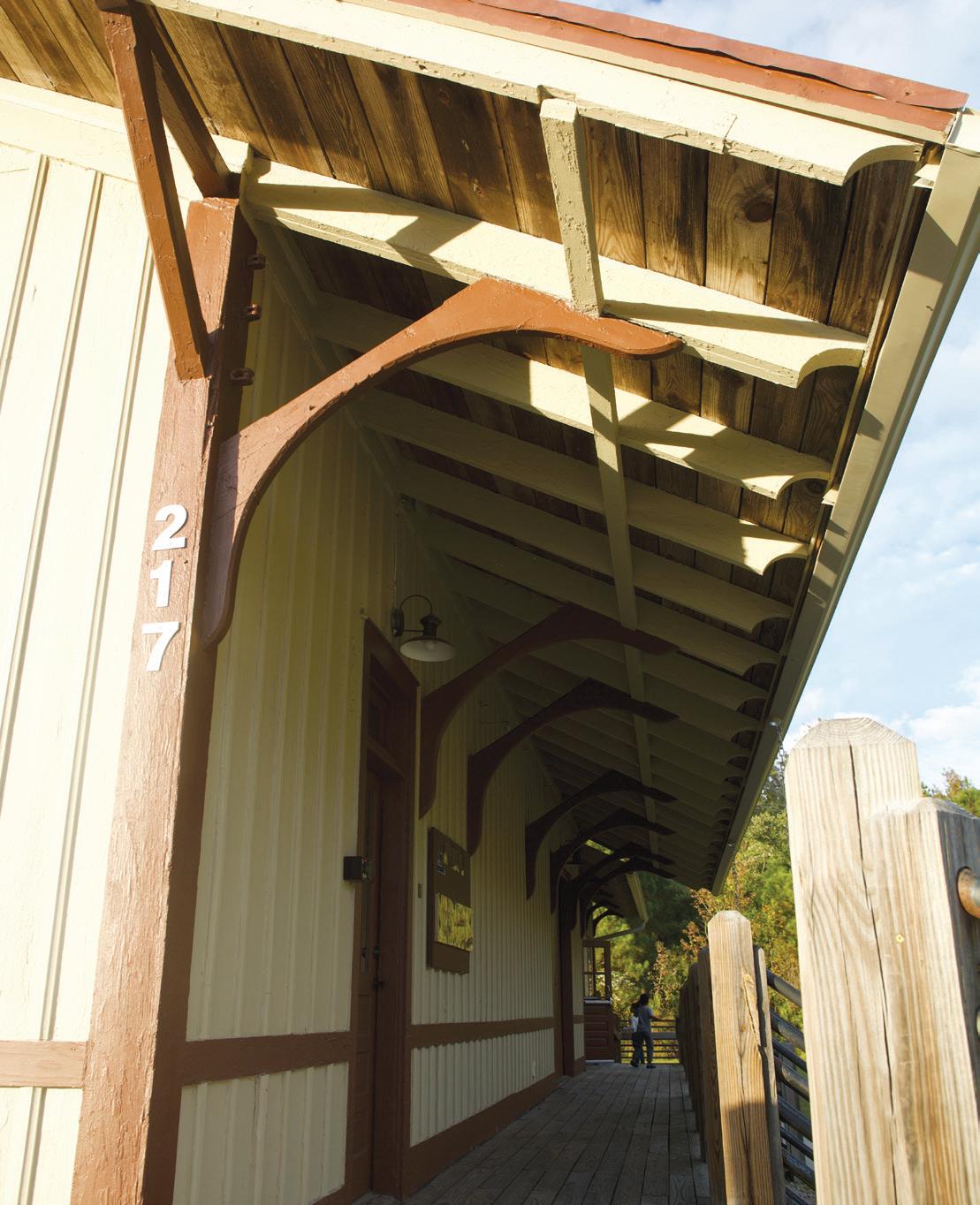
“It was really an identi able landmark of Winterville. It is one of the threads that tie to gether early Winterville with contemporary Winterville.” e depot has an outdoor platform that connects to the caboose parked next to it, a ticket booth, benches in the waiting area, a meeting room used for wedding receptions, birthday parties, family re
unions and more. It also con tains two restrooms, a storage area and a kitchen area with stove, refrigerator and sink.
It is owned and main tained by the WHAS and is available for rent. The society also uses the depot for membership meetings, historical presentations, and other events of com munity interest.
“The depot has been a wonderful asset to our community as we have so few event venues here in Winterville, so this provides a space for our community members to be able to use for a variety of different needs. The histo ry behind the space adds to the character and the uniqueness allowing it to be such a versatile space,” said Chamber Director Rebecca Caveness.
“ e Chamber began utilizing the depot just last year as a meeting place for our ambassadors, a networking space, and even a place to host workshops and ribbon cuttings. is has been very special for us as our o ce space is not really meant to be a venue. It has allowed us to host more for our members. In particular I think the ribbon cutting option for those with home-based businesses has been especially impactful.I think what the WHAS has done to restore and preserve the Depot for our community is so important, and I hope they know how appreciated it is.”
For more information and to reserve the depot contact the Winterville Historical & Arts Society at whs28590@ gmail.com or 252-321-2660.




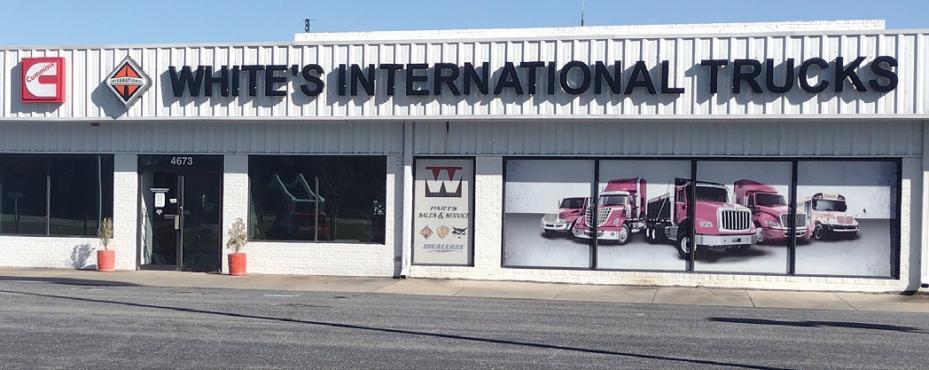
 By Donna Davis
By Donna Davis
Tall, feathery spines of asparagus grow with such wild abandon in a ower bed of the Cox-Ange House that an untrained eye would declare it a weed. But agri science educators advising
students ensure that remnants of the legacy kitchen garden are preserved.

e heritage plant is allowed to coexist with ower bulbs because it is a peren nial, unlike most vegetable plants. e horticultural incongruity parallels the contrast between high school students in jeans and modern accouterments — like hair the

color of a crayon — indus triously working around the historic home of generations prior.



































Future Farmer of America students from D.H. Conley and Farmville Central gath ered at Winterville’s history museum early on a gray, damp Saturday morning. Sau sage biscuits and sweet tea are provided on the porch, along with cold bottles of water in the refrigerator inside. “Help yourself,” Jesse Riggs of the Historical and Arts Soci ety and town historian
tells them. “You don’t have to ask.”












e students receive their guidance from Jonathan Riggs, agriscience instructor and FFA adviser from Farm ville Central and son of Jesse Riggs. Shelley Armour, the D.H. Conley teacher in a sim ilar role, is driving an activity bus for the marching band on this particular work day, but some Conley students still came out to help.
e student workers jockey for gloves, some quickly opting to do without, as their bulkiness can inhibit the ne motor skills required
Winterville Magazine 2022


to work with the most delicate plants, invasive varieties or not. ey break out into organized small groups, some plucking anything green growing through the ground cover around the foundation. Riggs is careful to point out the exceptions. e ivy growing near the steps will be spared for now, though cut back, to protect the wooden porch it is creeping toward. Others concentrate on di erent ower beds across the property.
“You should have seen that oval bed when we rst got started,” Jonathan Riggs explained. “It was so grown up.” Instead of pulling handfuls of weeds, now the work is more intricate. Some times students hold their phones up to a plant to take a picture or to use a plant identi cation app.
“Look! I found something!” one student exclaims as she holds a ten dril in the air. e rounded area near the root makes her think it might be a bulb of some kind. “It’s a spring onion,” Riggs tells her, somewhat to her disap pointment. But it’s still a nd, and the exchange shows the care the students are taking.
e young agriscien tists-in-the-making bend and pluck, eager to do what the casual observer might classify as backbreaking work. Seeing the progress fuels their enthusiasm and interest in the eld as a profes sion.
Melissa San chez, a senior, has been working with the project since her sophomore year. She’s the chapter reporter for the Farmville Central FFA and weekly posts an “Ag Fact Friday” on social media. It will be a random agriculture fact, such as a recent one about North Carolina being one of the nation’s largest hog pro
ducers. She already has plans to attend Lenoir or Pitt and then transfer to N.C. State in the agriculture eld.
“I like planting the plants and pulling weeds and putting mulch over them,” Melissa said. “And it’s very worth it. Even though we have to spend hours working, I honestly really enjoy doing it because of how much I love agriculture, and it makes such a di erence. I tend to take the before and a er pictures … and it looks amazing.”
Sybil Boberg from Farmville Central said she joined FFA “on whim” because she needed the credit. “But when I started coming to these events I discov ered a love for plants. Now that’s what I plan to do … go to N.C. State or University of Mount Olive and probably get a degree in Horticultural Science.” she said. “ e scariest thing out here are the plants that make you itch. ere’s Virginia Creeper in those beds over
there, but it’s not super bad.”
“I joined FFA because I wanted to be a veterinarian,” Caroline Leonard from D.H. Conley said. “But once I came out here I made a lot of friends and I discov ered a love for agriculture. So now I’m interested in horticulture science. is has been a great experience.”
Students from the two schools have been a part of the Winterville Museum Garden Restoration and Historic Plant Preservation Project since 2020. One might say it was one of the good things to come out of COVID. “During the COVID pandemic, we were severely limited in what we could do both on and o campus with our students during the school day, Jonathan Riggs explained, “So some of us agriculture teachers were looking for opportunities.”
It’s not like the Ange house — the museum — was new to Jonathan Riggs. His father, Jesse, had been bringing him out there since he was a small child. Jesse shares a photograph of Jonathan posing with a Cox Cotton Planter patented by his great-great-great-grandfather, John Cannon Cox. e cotton planter is on display at the museum. So perhaps it’s appropriate to say the museum’s land scaping needs represented low hanging fruit for the agriscience teacher.
Shelley Armour explained that prior to COVID she and Jonathan Riggs had talked about applying for a grant through the National FFA’s “Living to Serve” program to restore the gardens at
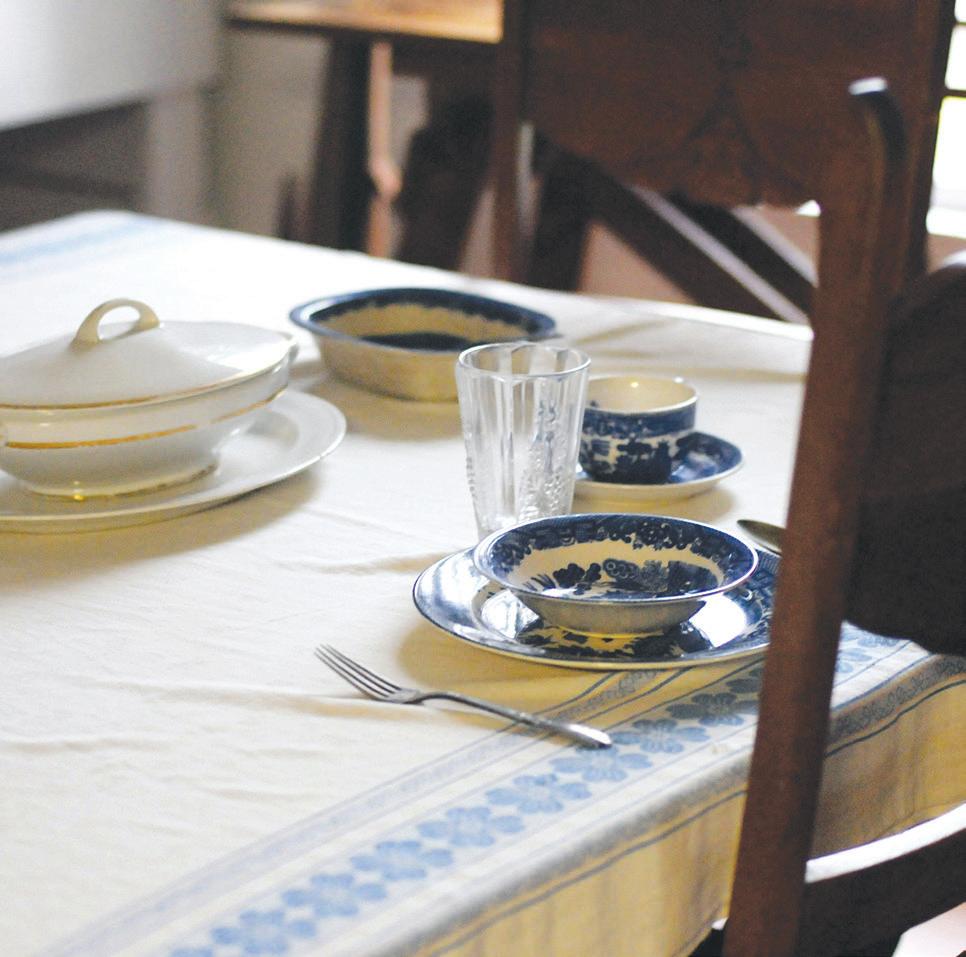

the museum.
“We both received the grant, and when COVID hit and our school world changed so drastically, we had to brainstorm on how to keep students involved,” she said. “FFA is an intra-cur ricular (not extracurricular) organization that is part of our agriculture education programs; activities are done in school and outside of school.”
By working outside, they felt they could keep the stu dents safe and still involved.
e working days at the museum were initially about identifying plants, pulling weeds, as well as mulching and mapping the grounds.
e landmark white house with its distinctive sleeping porch and two-person facing swing is nestled on Church Street, anchoring the center of town. But once it was considered on the outskirts, Jesse Riggs said. e CoxAnge house, now known as the Winterville Museum, was built in 1901, lived in for gen erations, and then donated by the Ange family in 1996 for preservation.
“Mrs. Ange, who moved in with her husband in about
1902, was an avid gardener,” Jesse Riggs explained. She loved the diversity of plant life and was known for having exotic plants, along with a kitchen garden.
“ e FFA groups, and Jonathan and Shelley have really been instrumental in helping to locate and recover some of those original plants. And they’re also helping us rework the yard a little bit so it maintains its historical a vor, but at the same time, it’s easier to maintain in modern times.”
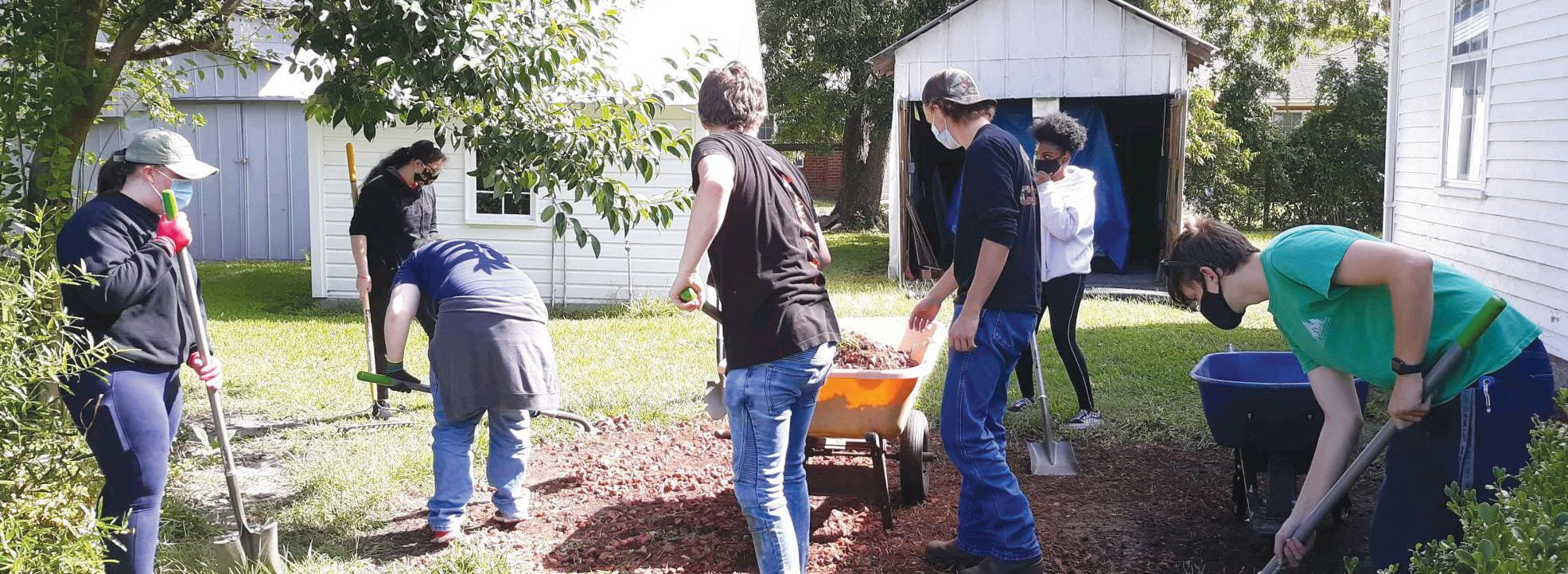
rough their excava tion process — almost like archeology for plants — some of the discoveries have been nandina, or “heavenly bam boo,” hurricane lilies, and old er styles of rose bushes, like the Confederate rose. “I like to point these out to students to look at the owers and smell them,” Shelley Armour said. “Many hybrids we now purchase in big stores don’t smell, but these still have their perfume smell because they are an older variety.”
Earlier in the project, one of her students didn’t recognize the rose bush and cut it to the ground. “She was horri ed when she ‘killed’ an

heir loom plant. I think she apologized a million times. I told her it was OK; number one, she is learning and, number two, rose bushes will come back as long as the roots are good, which they were. Today it is owering beautifully and we are trying to train it to use a trellis. We all make mistakes and it is a learning process.”
e groups plan for monthly workdays, but in the winter months, not much needs to be done, and in the spring sometimes they work several times a month.

“I think one of the biggest surprises, for me, is how involved the students have gotten,” Shelley Armour said. “ ey always want to know the next work day date and really have engaged in the project. I personally don’t teach horticulture (my program is Animal Science and Sustainable Agriculture right now) but my students have taken a vested interest in this project. It also tells me that maybe I do need to be o ering horticulture! I think this project has pulled them in because Mr. Jonathan Riggs and Mr. Jesse Riggs have made the history come alive for them, of not just the museum but the history of Winterville.”
A signi cant number of ower bulbs have been recovered or rediscovered, especially da odils, tiger lilies, daylilies and hurricane lilies, also known as spider lilies. Jesse Riggs explains that ower bulbs were o en
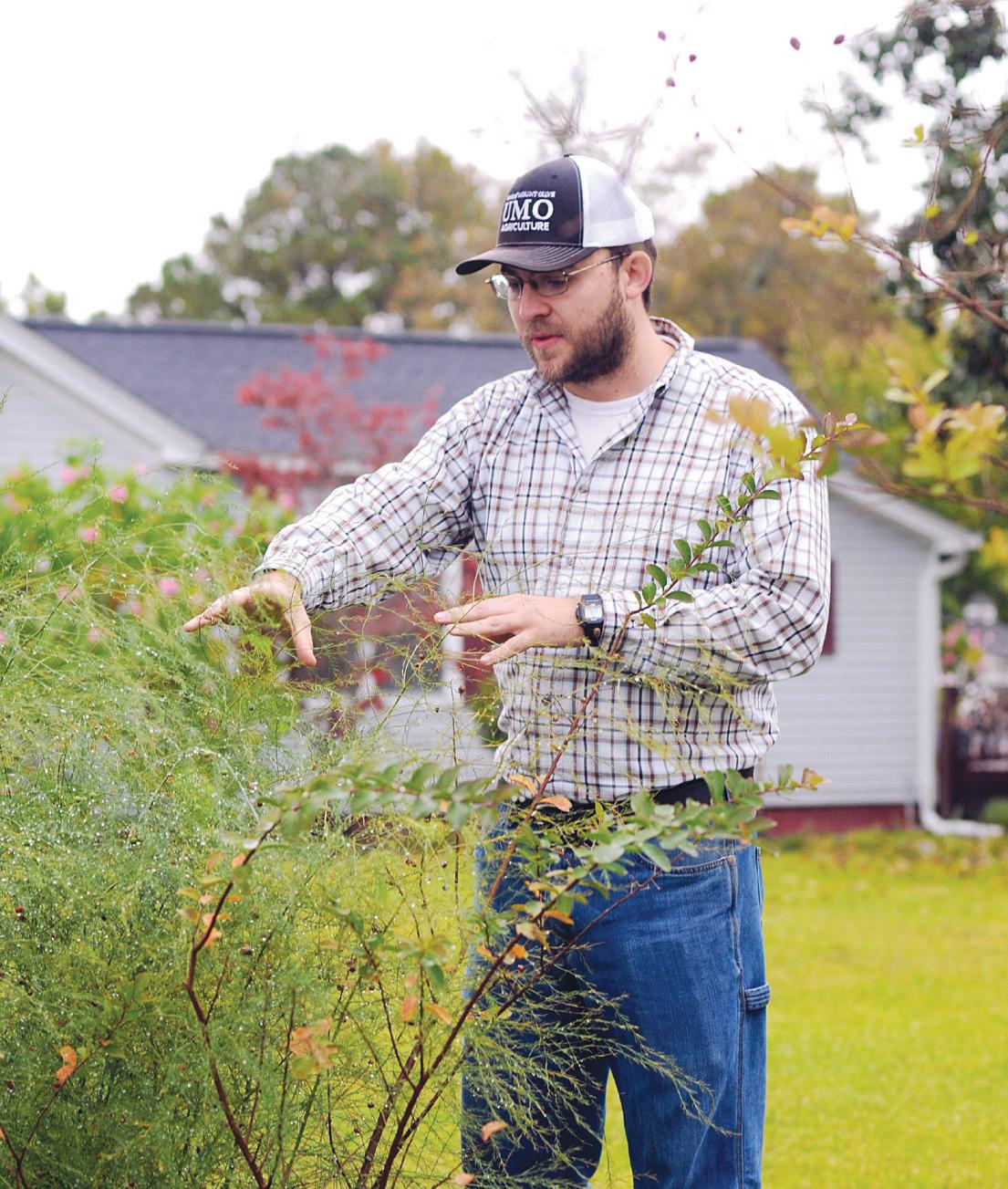
shared between friends and family.
“We’ve been routinely watching for bulb owers to pop up in the lawn then marking those spots to keep them from being mowed over, as they likely were for many years,” Jonathan Riggs said.
Some varieties of da odil are more vintage and the teams can estimate when they were popular. e white petal, yellow cupped vintage da odils found at the muse um were a precursor to the popular “ice follies” variety, and he believes were likely planted pre-1950.
e museum has a doc ument prepared by Tryon Palace horticulturists in the 1990s as a point of reference. At that time, they document ed all the di erent plants and trees they could nd on the property. Some of the trees on the list are now missing from the property, Jonathan Riggs noticed, but also acknowl edges there have been several hurricanes in the area since then.
As a result of this project, the teachers have seen their students develop a deeper appreciation for landscaping work in general. “Just some basic work on garden beds and borders on the museum grounds has vastly improved the look and feel of the house and property,” Jonathan Riggs said. “ e students take pride in that. ey also have a better appreciation for vin tage plants and the historical
preservation aspect. I think the historic preservation ‘bug’ has ‘bit’ a few of the kids.”

The future of historical preservation is looking bright for Winterville as Jesse Riggs explains, “The youngest member of the historical society is here, having breakfast in the dining room.”
Like his father brought him out to the museum as a child during workdays, Jonathan Riggs has con tinued the tradition with his 8-and-half-month old daughter.
The partnership between
the local historical soci ety and the FFA chapters has been a win-win, and Jonathan Riggs says as
far as they know, has the distinction of being unique in North Carolina and pos sibly in the country.
Winterville Museum Gar den Restoration and Historic Plant Preservation Project supporters

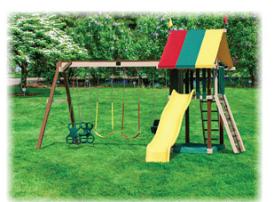


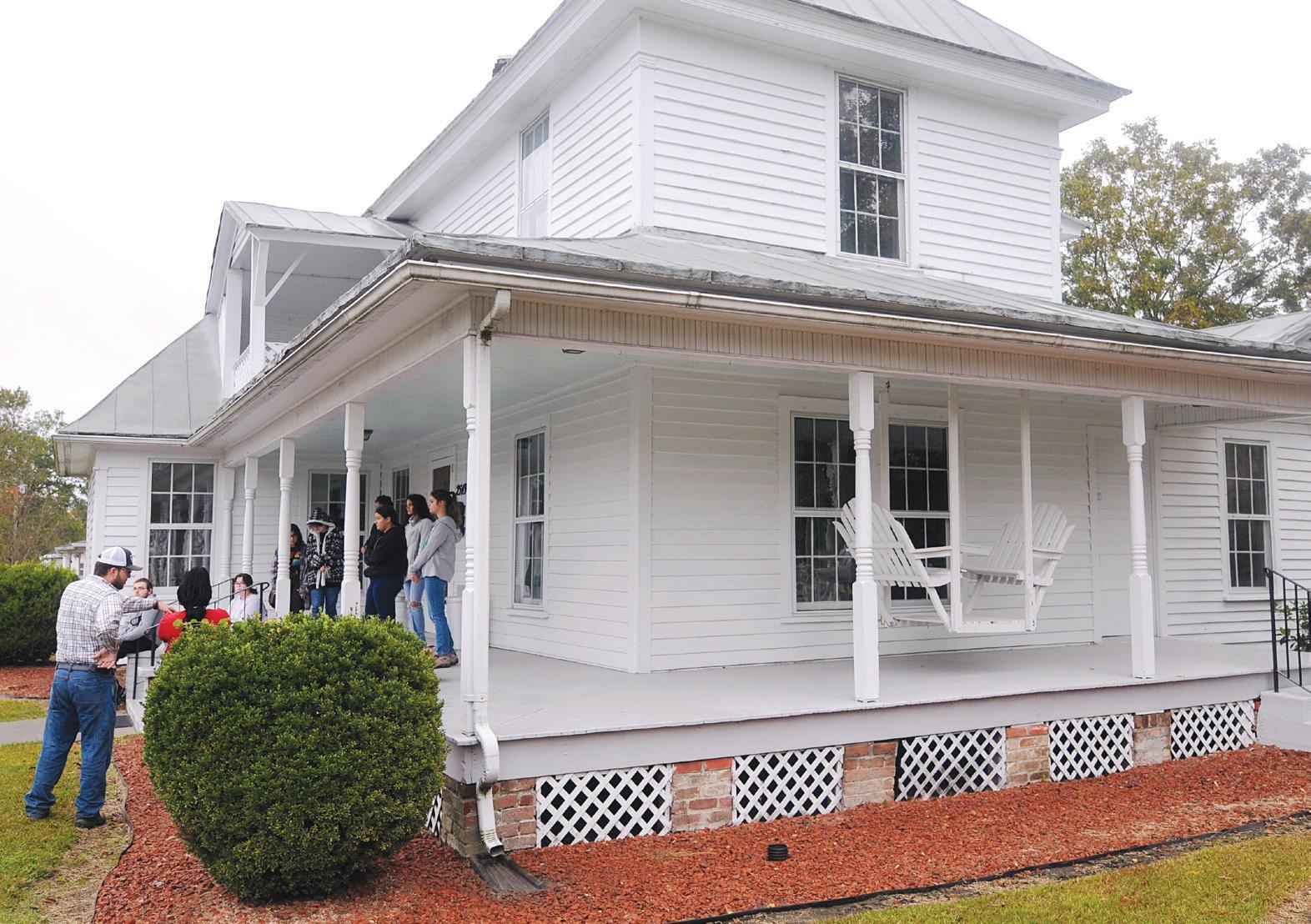
– Shelley Armour ac knowledges: Mr. Jesse Riggs, Mrs. Danielle Riggs (she was supporting the project before she became the coFFA adviser at FCHS), Mr. Don Marr (principal at DHC when we started the project), Dr. Michael Swinson (cur rent DHC principal), Mr. Brad Johnson (FC princi pal), FFA members parents (several members don’t drive yet!) and the Winterville Historical Society that is allowing us to do the project.
– Jonathan Riggs ac knowledges: e Board of Directors of the Winterville Historical and Arts Society
has been extremely support ive and deserve recognition. Speci cally Jesse Riggs (Vice President) who helped pioneer this e ort and even assures that our student workers have breakfast or snacks each workday; and also Mr. Abbot Hunsucker (Treasurer) who has helped identify many of the needs for the project and secured some funding for materials.
– Additionally, the sup porting organizations for the National FFA “Living to Serve” grant program (Tractor Supply Co and Cargill) for funding grants which both DH Conley FFA and Farmville Central FFA were able to secure for materials for this part nership (each school was awarded $3000).


Aeld where a nonpro t that serves children with autism is put ting down roots is less than a mile from where the organiza tion’s founders live. But the multi-million
dollar campus taking shape on what was once farmland is an example of how far Aces for Autism has come since it began less than a decade ago.
Aces marked the launch of the Ron and Rose Bowen Family Autism Campus on Worthington Road with a ground-breaking ceremony

in October. e rst phase of construction for the 24acre site is a $13 million, state-of-the-art clinic. e 32,000-square-foot SECU Autism Clinic of Eastern NC, funded, in part, through a $1.5 million grant from the State Employees Credit Union Foundation, is expect ed to be completed by the spring of 2024.
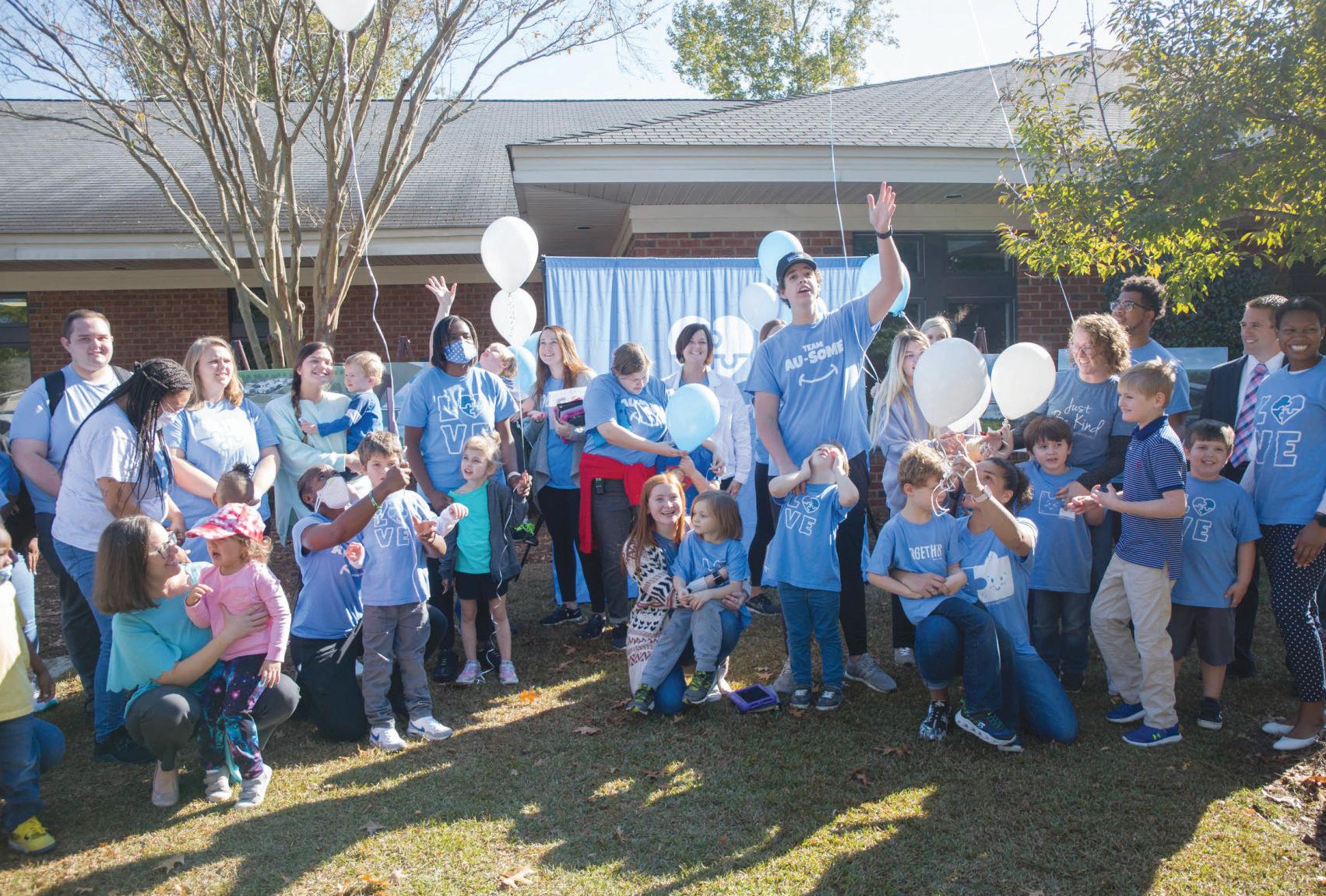
Mayor Ricky Hines, whose family has been a ected by autism, said he is grateful to Aces co-founders Kyle and Bobbie Robinson for choosing Winterville as the location for the new treat ment center.
“Without your vision, we wouldn’t be here,” he said at
the groundbreaking. “ ank you for bringing this here because this is going to be a tremendous impact for this town.”
Kyle Robinson said the land that the Bowens pur chased for Aces in 2018 pro vides an ideal setting for the campus, which is expected to eventually include a school facility and recreational space.
“We wanted a place where when you pull onto the land you feel a sense of calmness, a peaceful environment,” he said in a later interview. “ at has it out there.”
e campus, located next to Christ Covenant School, plans to serve as many as 150
chil dren through learn ing labs to replicate experiences a student might have in a grocery store, bar ber shop or dentist’s o ce. In addition, a mock apart ment will help train students on practical living skills such as laundry and food prepa ration. e outdoor space, which Aces plans to enhance with additional trees, will in clude playgrounds, a walking trail and a splash pad.
Even before Aces began building, Kyle said the cam pus had already begun draw ing families to Pitt County’s second-largest town.
“From a location stand point, what we’ve learned is if the resource is there, fami lies are going to nd a way if that’s where their child needs to be,” he said. “One family moved and bought a house in Winterville to be close to it. People will relocate to be close to something that’s going to help their child.”
at is essentially what Bobbie Robinson did when Samuel, now an 11-year-old h-grade stu dent at Open door School, was diagnosed with autism at 18 months old. She le her teach ing job and spent weekdays living with her parents so that she could take her son to ABC of NC
in Win ston-Salem for applied behav ior analysis therapy.
Although Bobbie had expe rience leading an elementary classroom, she had little knowledge of autism, having taken only one class in special education during her undergraduate years.
“When we heard Samuel was diagnosed, autism was just a bold-print word in a text book, basically,” she said. “I always say if I knew what I know now, I feel like I could have made a bigger impact on those kids that had autism in my classroom.”
As a physical education major during his undergradu ate years, Kyle also had limited exposure to students with spe cial needs. He
re
quired him and other students to go to schools to work with children with disabilities.
“I always remember going to those schools and (seeing) kids with profound disabilities and thinking ‘I never could do this,’” he said. “Now we’re here today. It’s amazing.”
When the Robinsons launched Aces in 2014, neither one of them envisioned leav ing their chosen career elds for a eld of dreams in Winterville. In 2016, as Aces began seeing its rst patients in classroom space provided by a local church, Kyle was di rector of basketball operations at East Carolina University. Bobbie was a teacher at W.H. Robinson Elementary School. “I thought I’ll always be

purchase of an 11,000-square-foot clinic in 2019, Bobbie began to sense that she needed to step into a new role.
“I remember praying through it and (saying), ‘Lord, are you sure?’ because I loved my job. (But) God really opened the door to step in over here,” she said. “I remem ber crying on my last day at school. It was the ending of a chapter, but I knew that God was in the beginning of the next chapter at Aces.”
Bobbie became its director of community and family relationships in August of 2019, helping to guide families whose children were recently diagnosed with autism and overseeing the establishment of Aces’ child development center. Kyle would not join the sta as chief executive o cer until two years later. Although he had obtained a master’s degree in administration and had budget and hiring respon sibilities in his role at ECU, he was initially hesitant to make the change.
“For me, being in college athletics, college basketball, that was my dream,” he said. “Doing that for almost 20 years was very rewarding, but there were times as Aces grew I felt like I was trying to work at ECU and then work all night on Aces.”
Kyle said that time at home during the coronavirus pandemic helped him to see what he needed to do.
“ECU shut down; Aces, during COVID, had to adapt,” he said. “It allowed me to slow down a little bit and realize Aces is where I needed to be. We never envisioned actually becoming employees
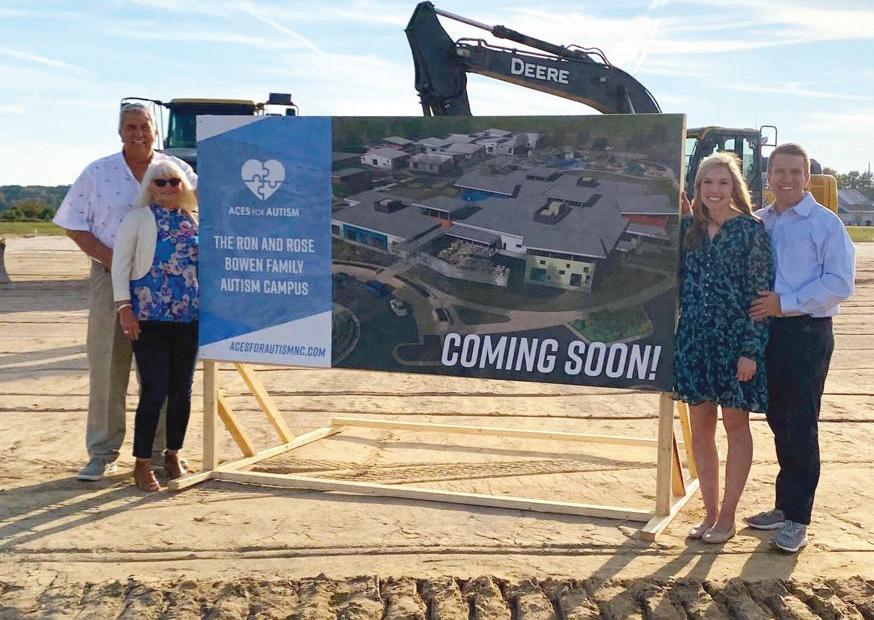

of Aces, (but) we couldn’t have made a better decision.”
As the Robinsons have made Aces their profession as well as their passion, they also are continuing to advo cate for legislation bene fiting families of children with autism. Following lobbying efforts for insur ance reform and to reduce regulations regarding applied behavior analysis, they are seeking legislative changes for children who have home-bound or mod i ed day placements that prevent them from attending school full time.
e Robinsons also have been able to foster friend ships with other organiza tions assisting the autism
community, especially in rural areas. e two serve as a resource for Partners for Learning, a new nonpro t for children with autism in Rowan County.
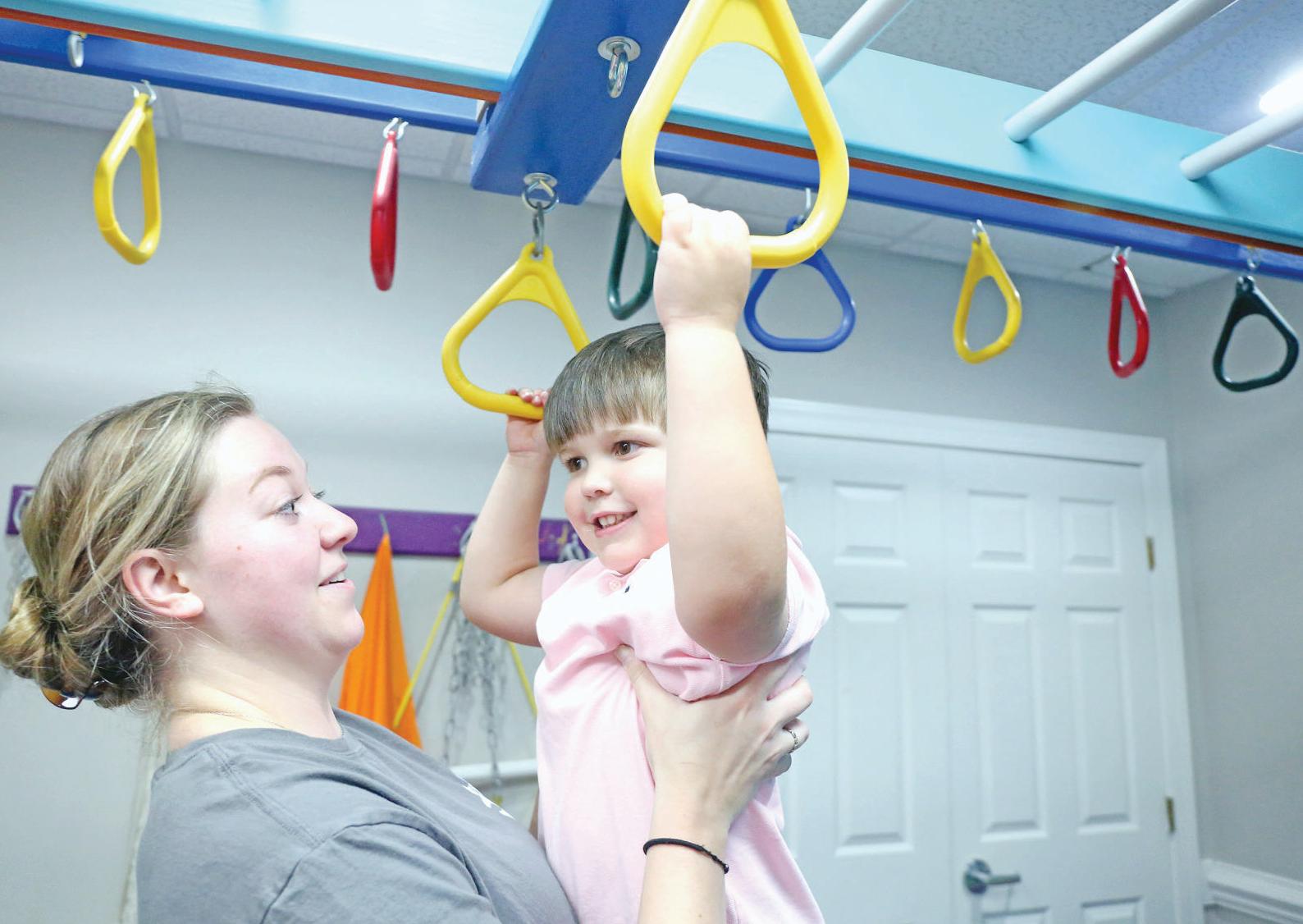
Closer to home, they have launched Together Aces for Autism (acestogether.com), a $25 million capital campaign for construction of Aces’ family autism campus. e organization, which brought in $179,000 from last month’s Samuel C. Robinson fundrais er, has received $7.1 million so far toward an initial goal of $15 million.
“I can’t say enough how much this community has really walked alongside Aces for Autism,” Kyle said. “We wouldn’t be where we’re at
today if it wasn’t for this community.
“When we started Aces, our ultimate goal was to build an autism campus that had a clinic and school and community buildings, that had everybody in one space like a little community,” he said. “We’re going to need some extra help to do it.”
Rebecca Caveness, executive director of the Winterville Chamber of Commerce, said breaking ground on the new facility is no small feat. She expects the autism campus to have a positive impact not only on Winterville and Pitt Coun ty but all of eastern North Carolina.
Bobbie is looking for that
impact to continue for years to come.
“Just like Samuel’s story has had a ripple e ect on the community, each person that donates creates a ripple e ect,” she said. “ ere are so many families who already have the diagnosis. But next week, next year, years to come, the com munity is still going to be pouring in to be able to help those families.”
Aces for Autism is cur rently located at 925 Confer ence Drive, Greenville, but is building a clinic at 654 Worthington Road, Winter ville. Visit www.acesforau tismnc.com or acestogether. com.
